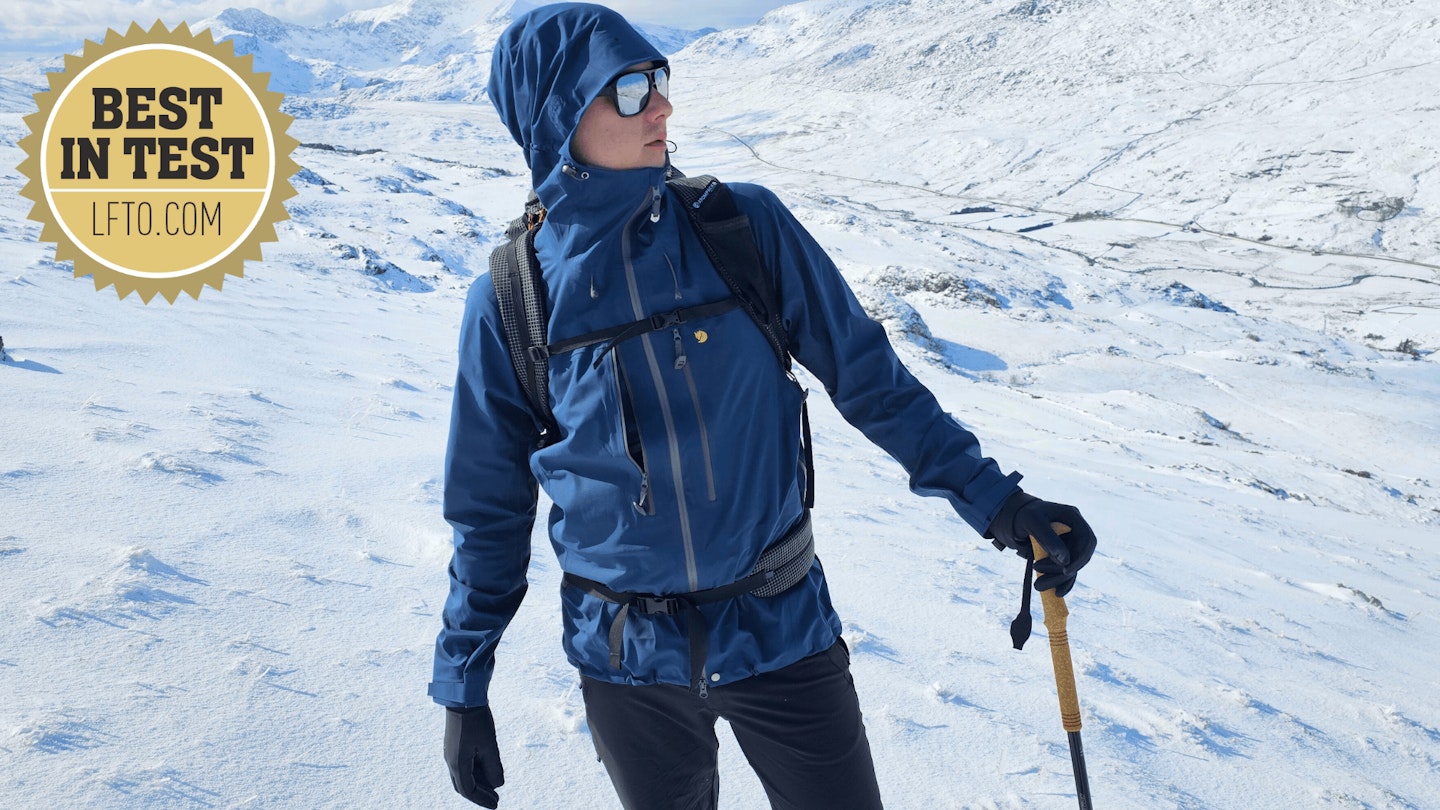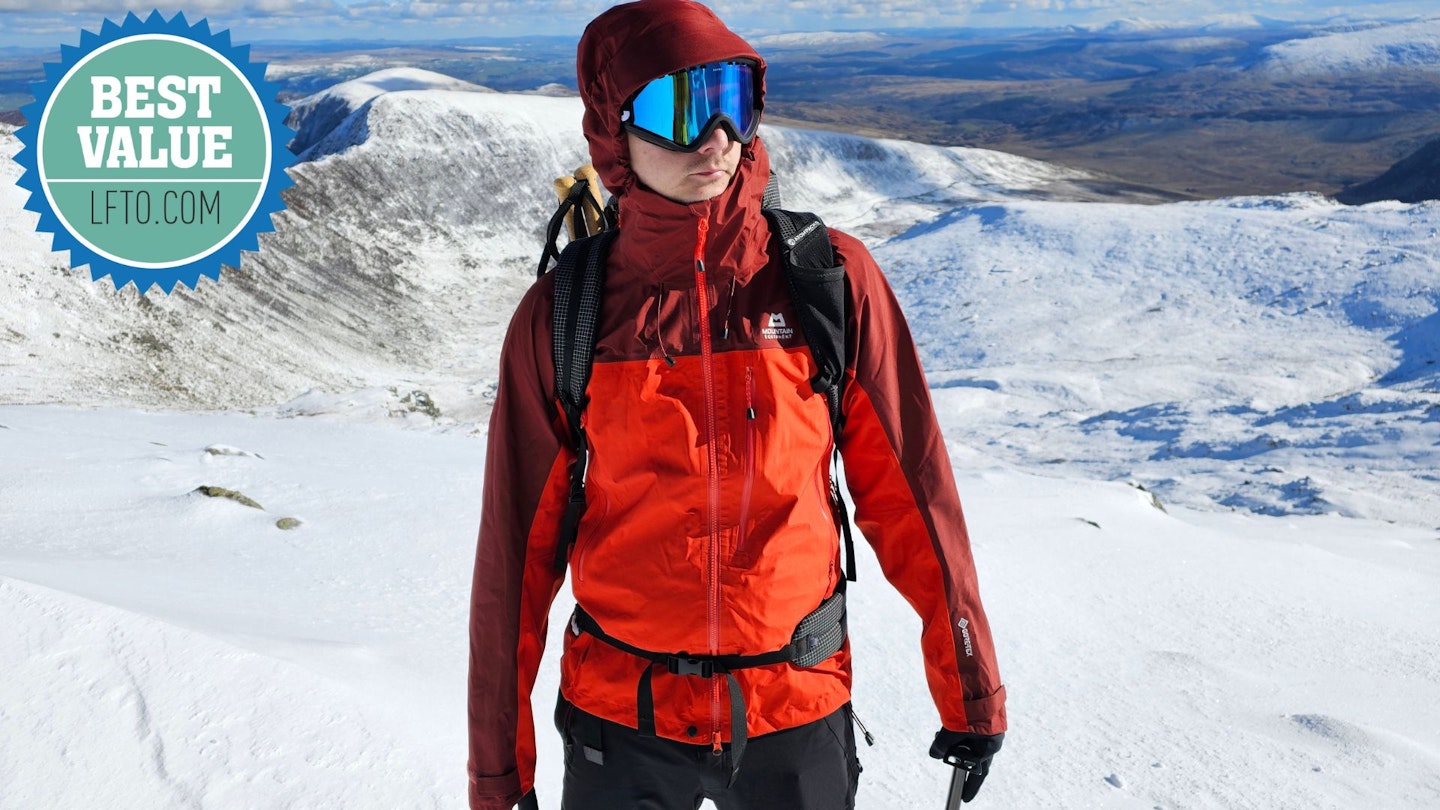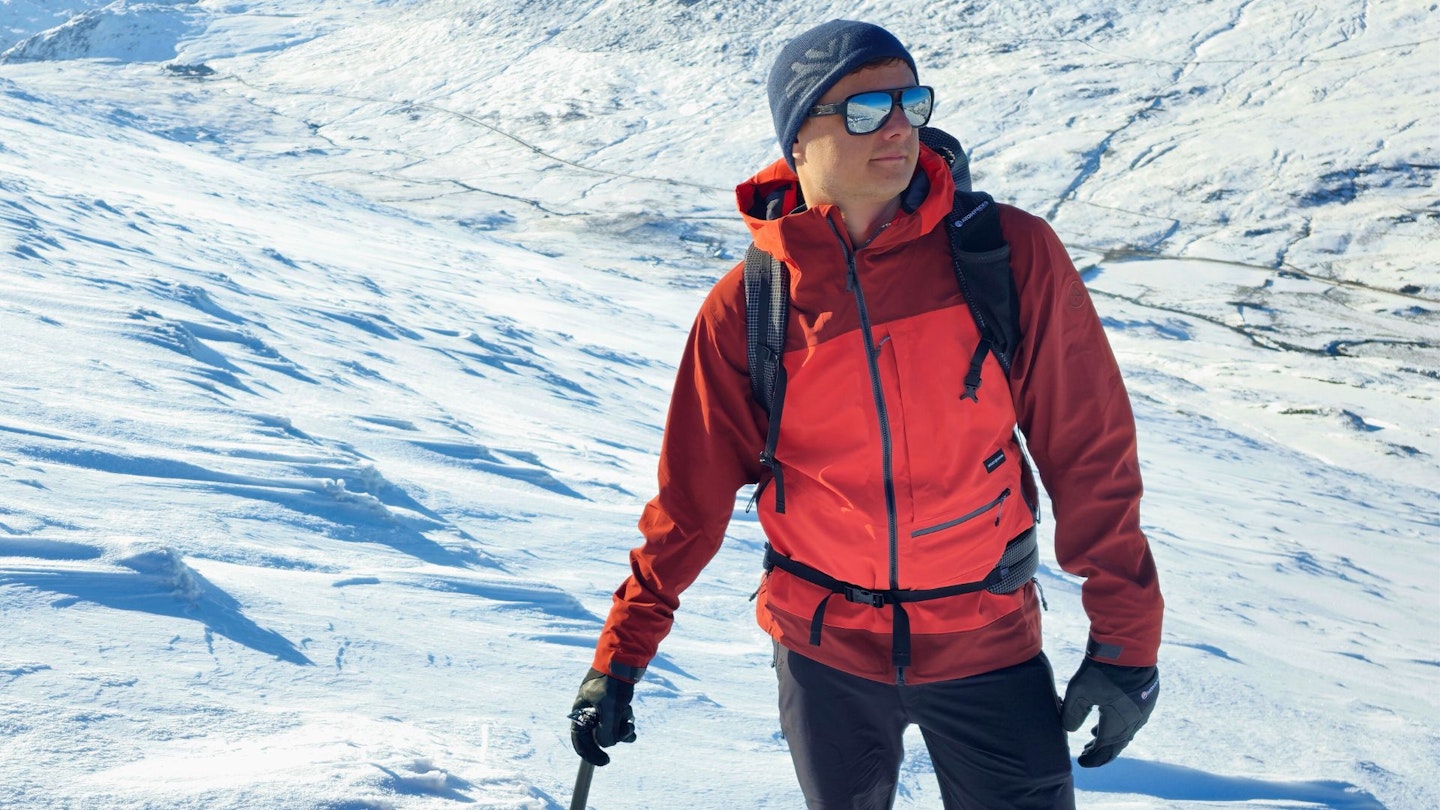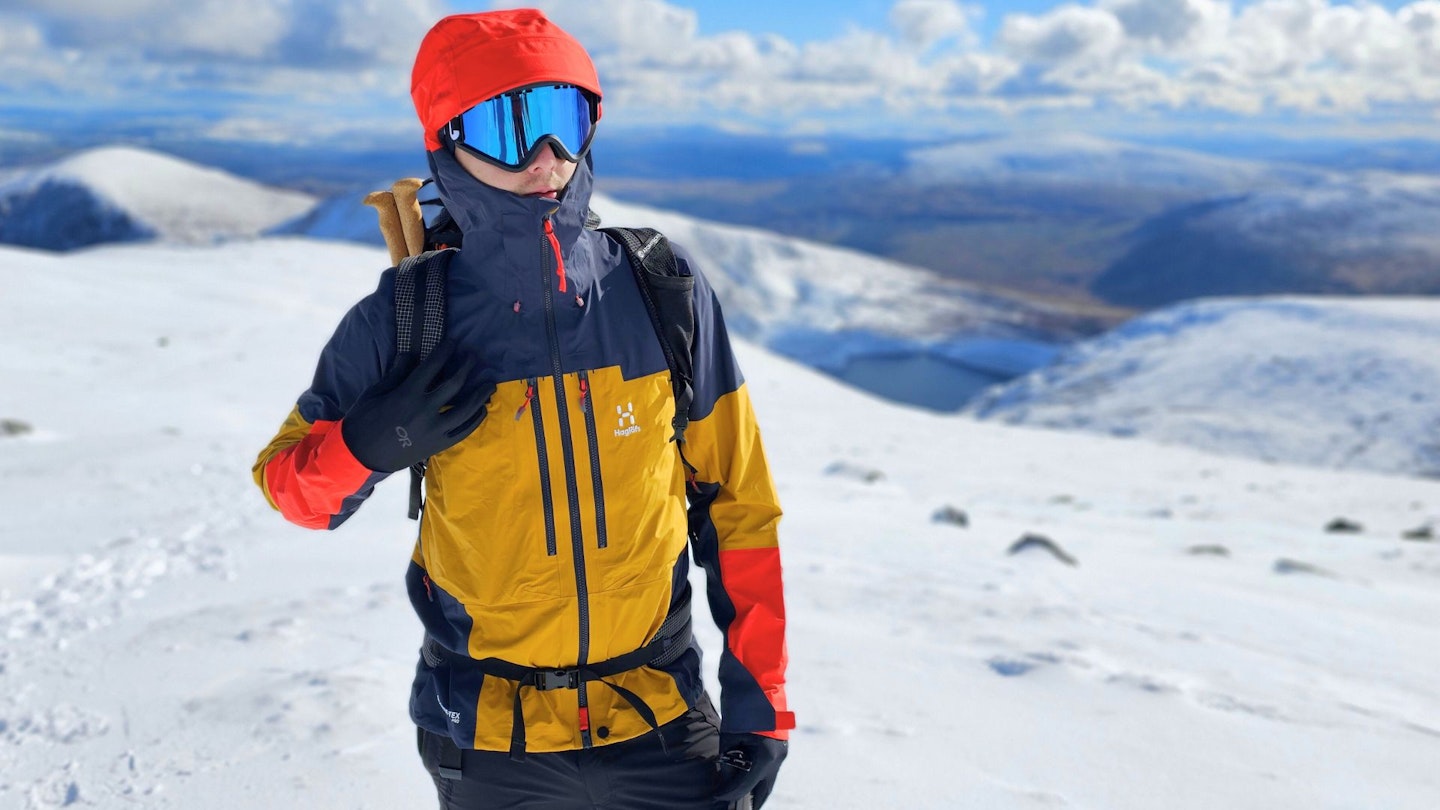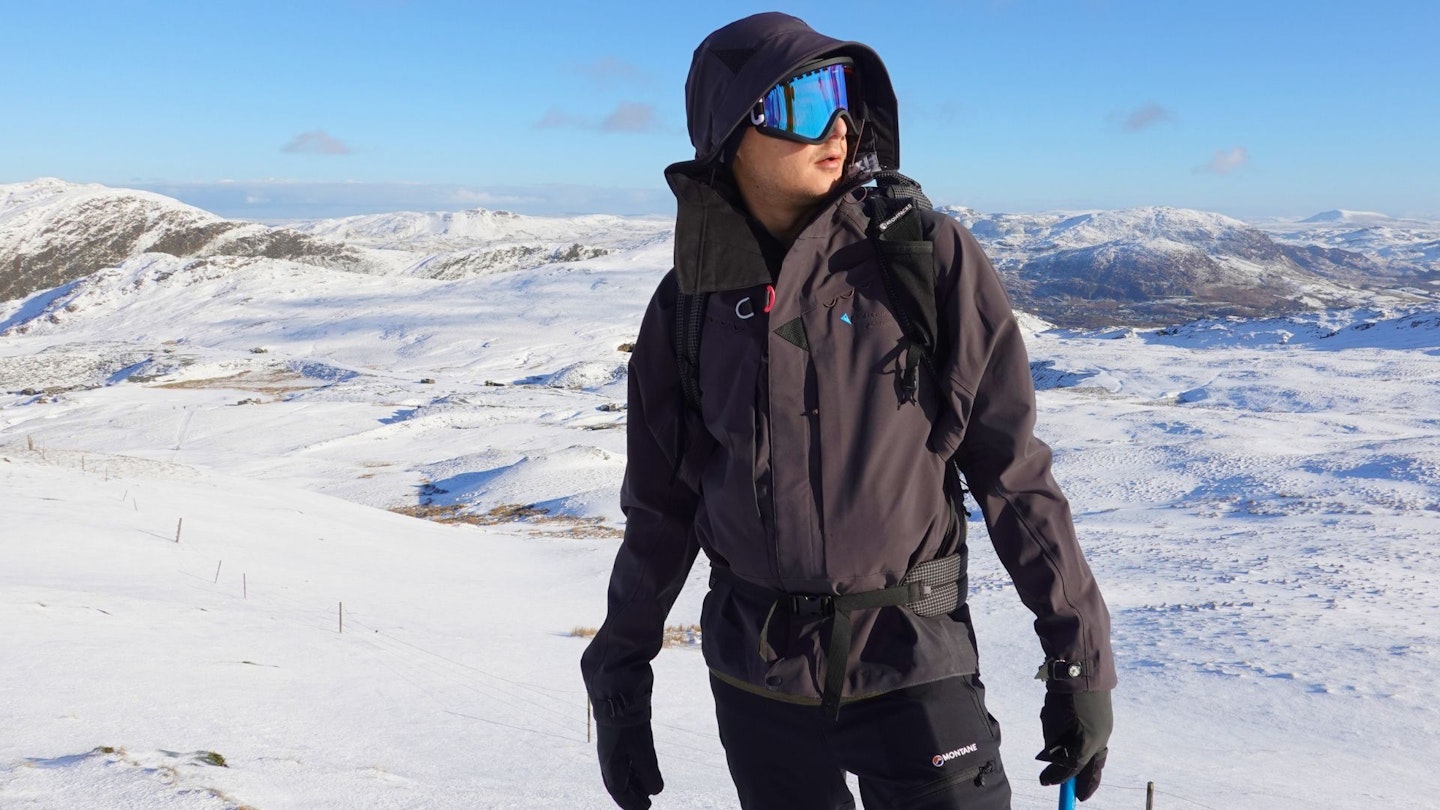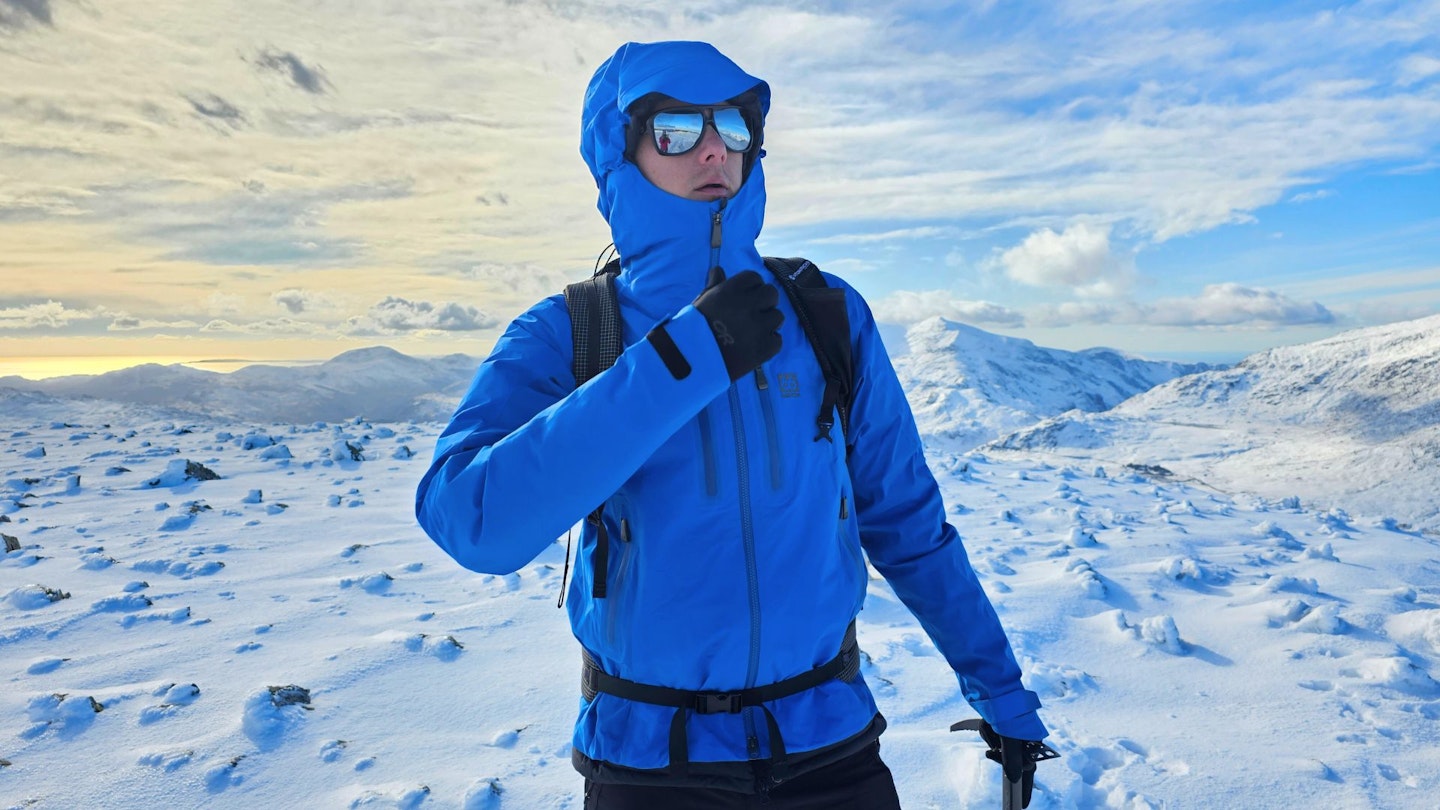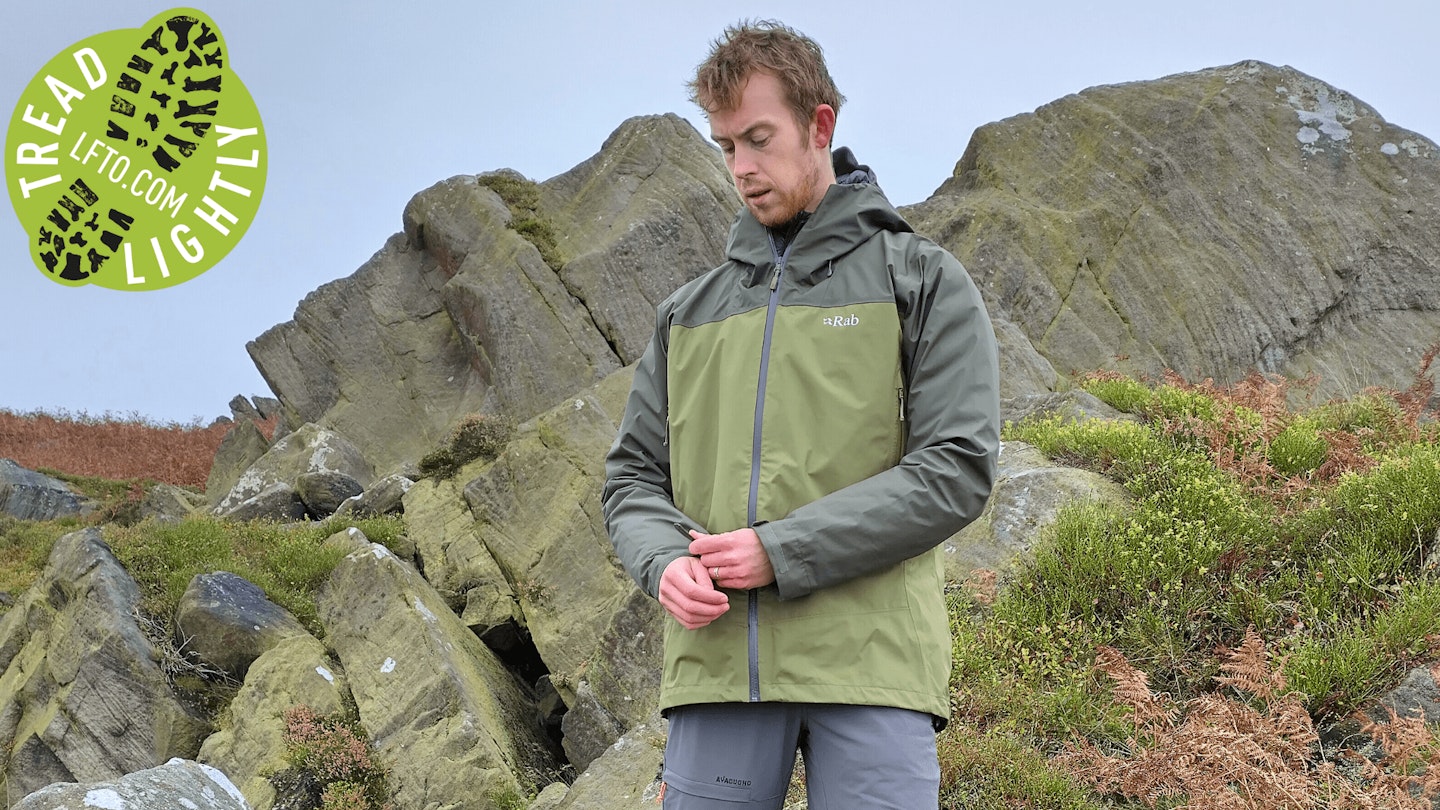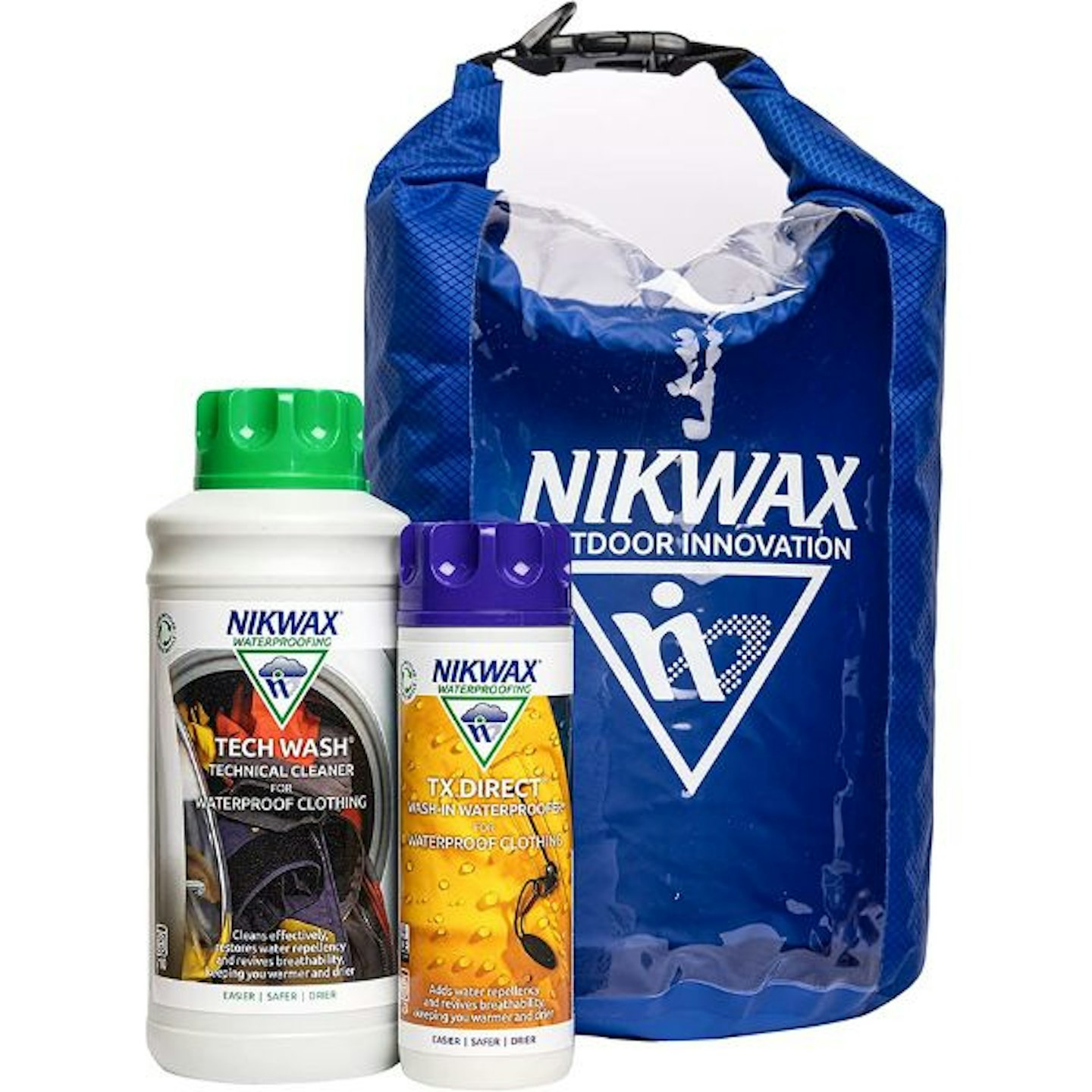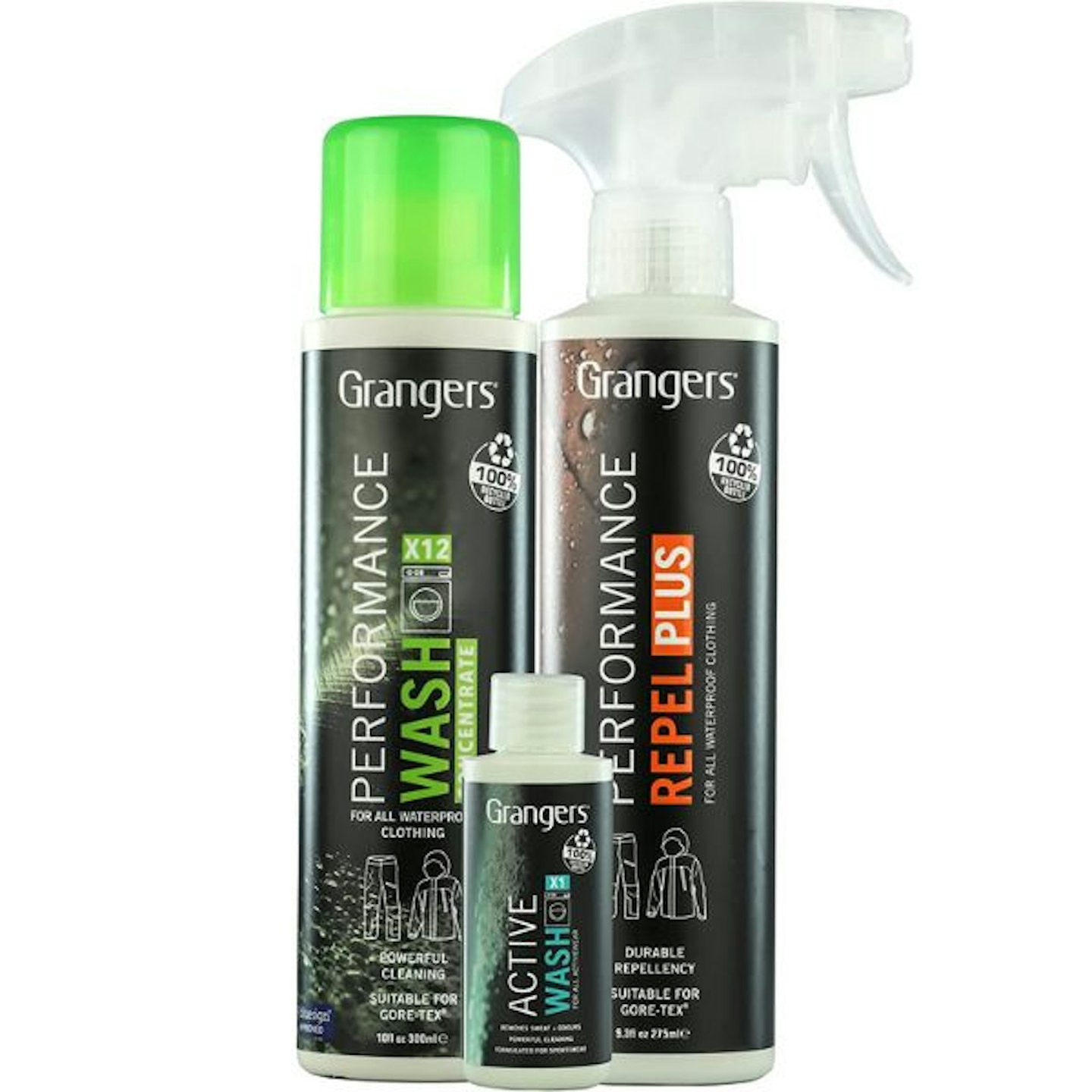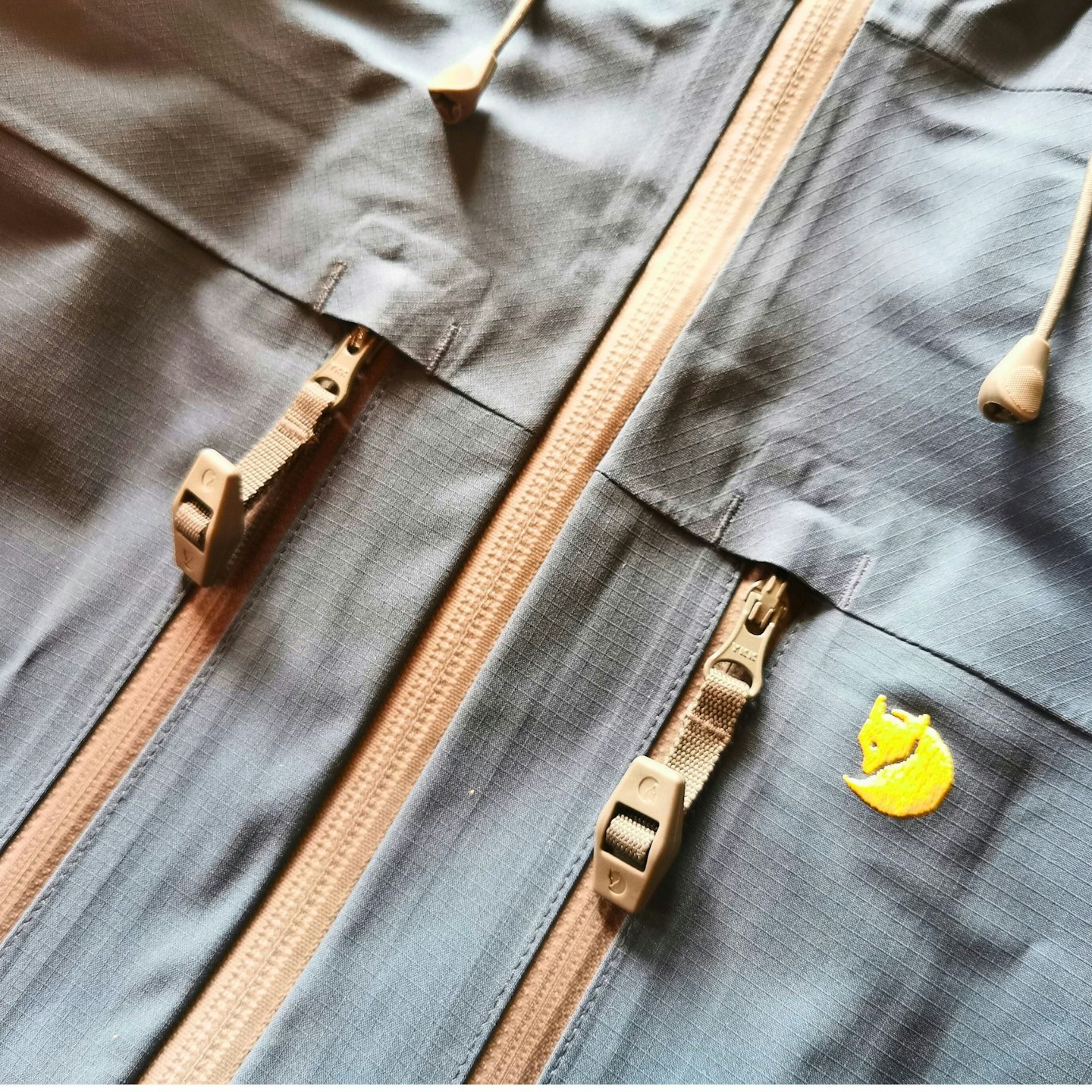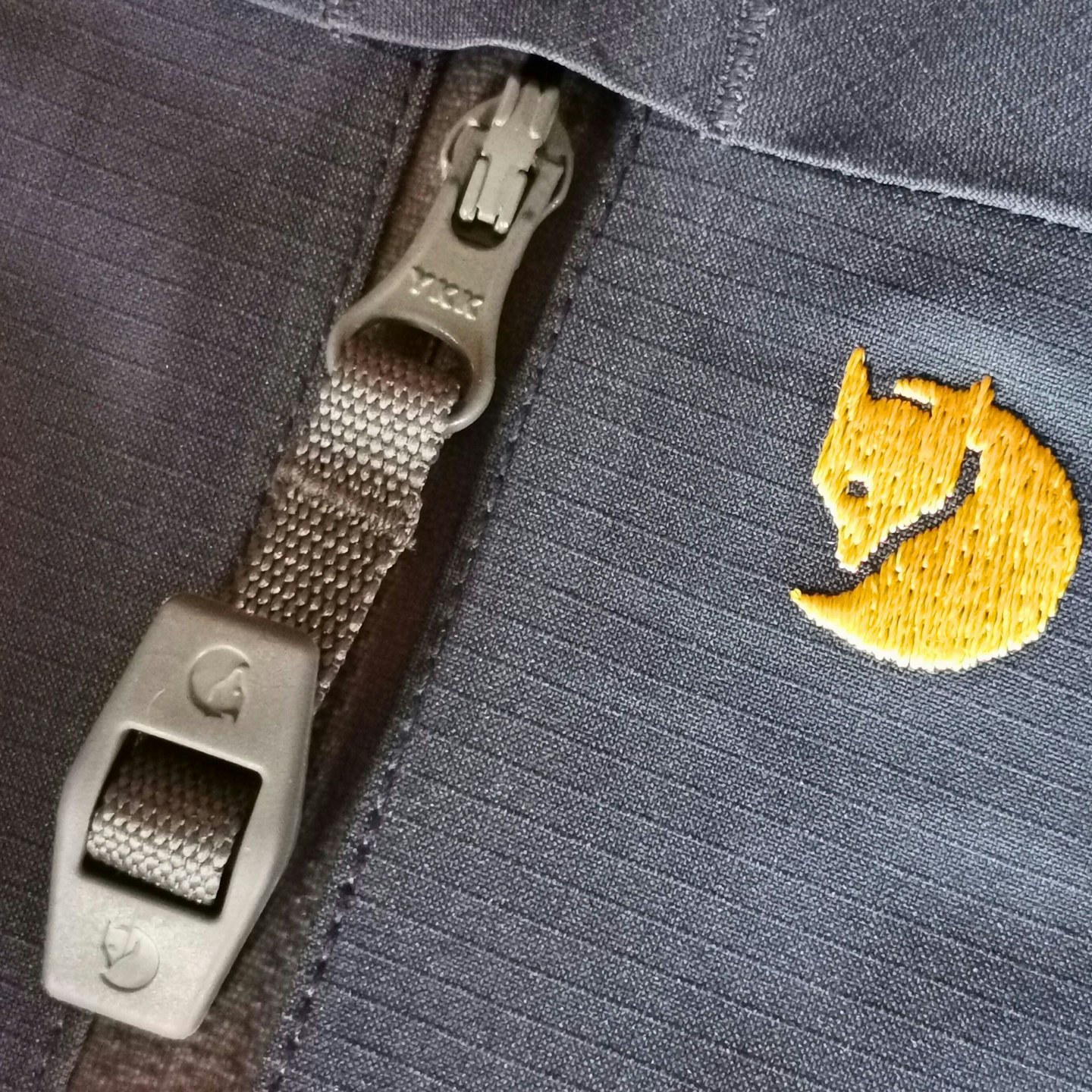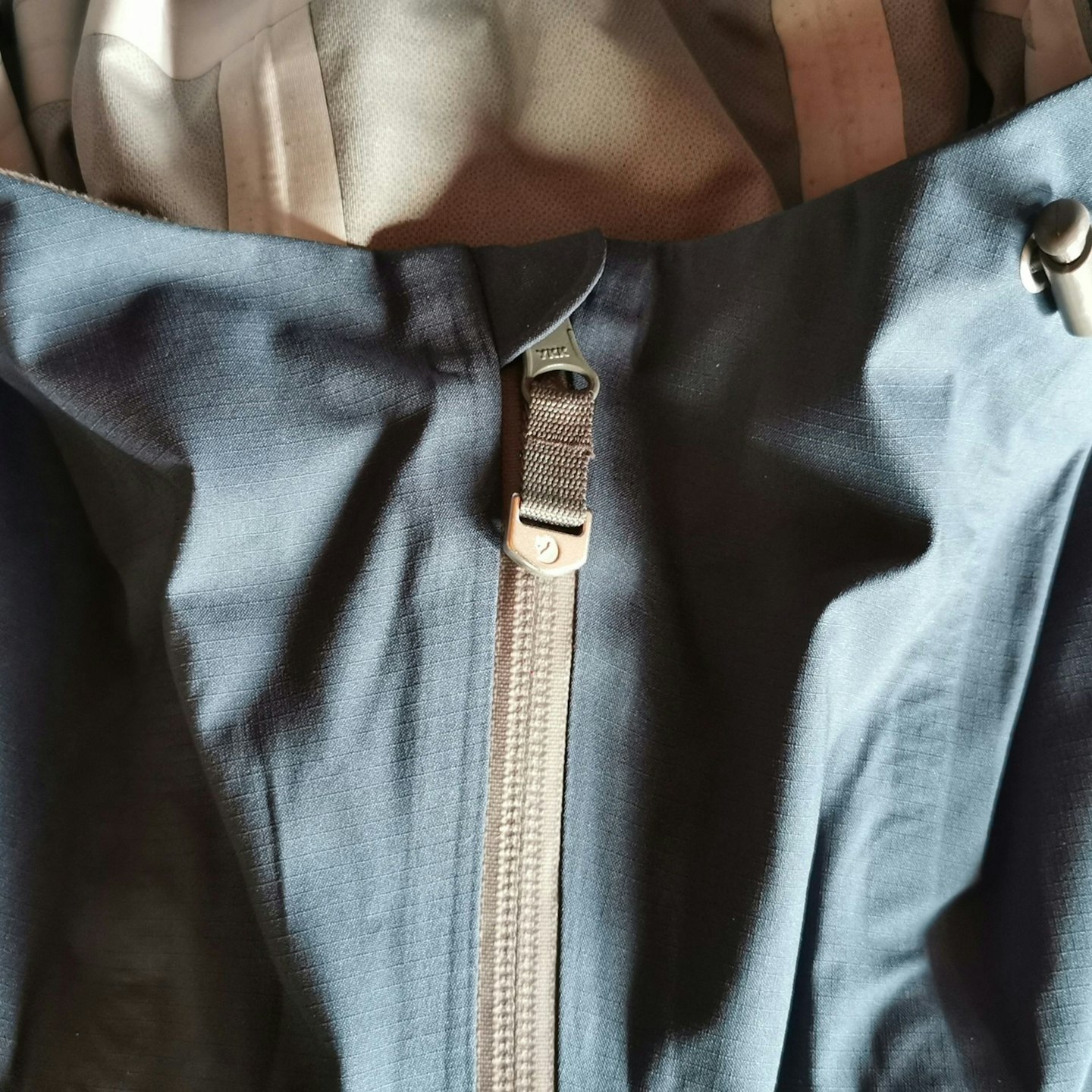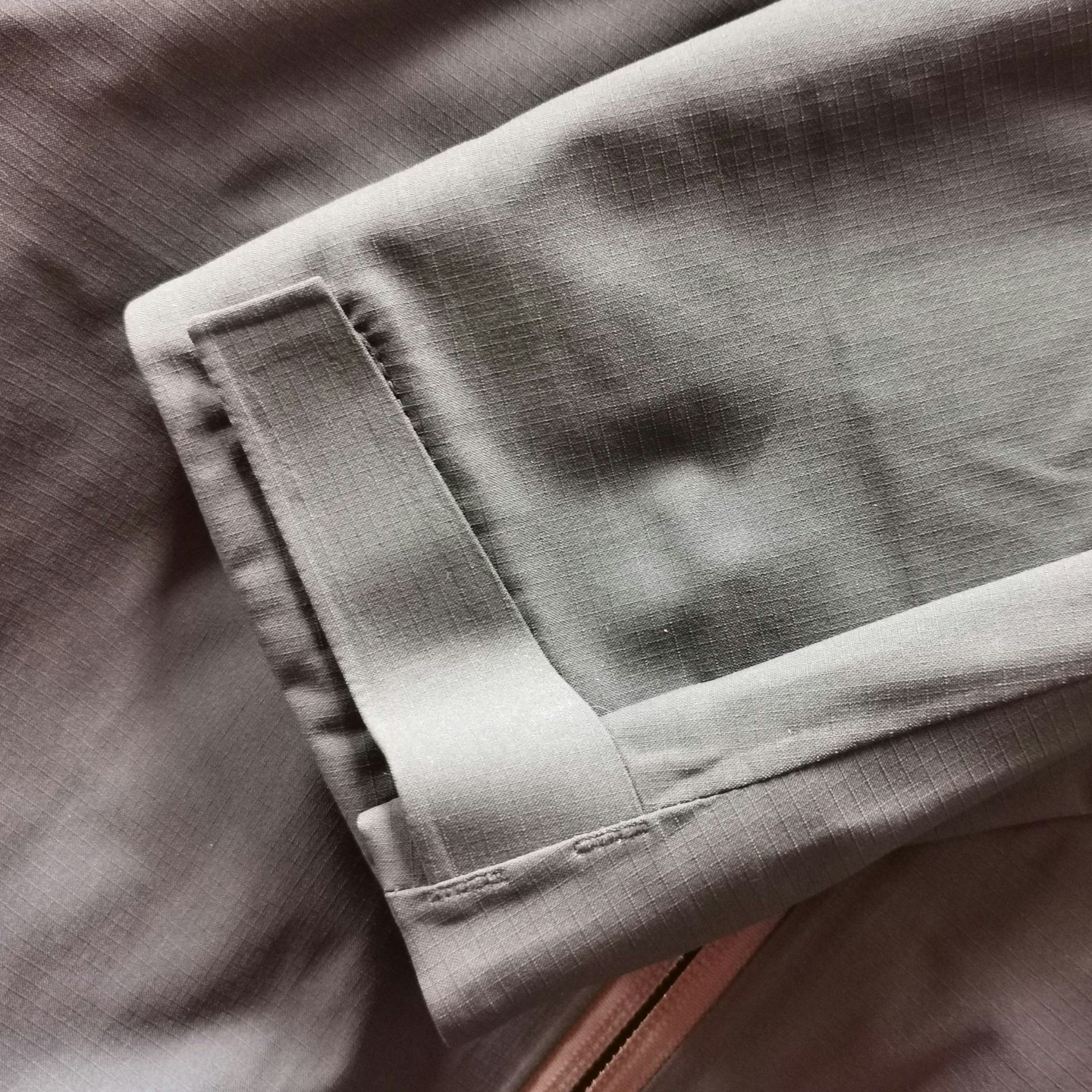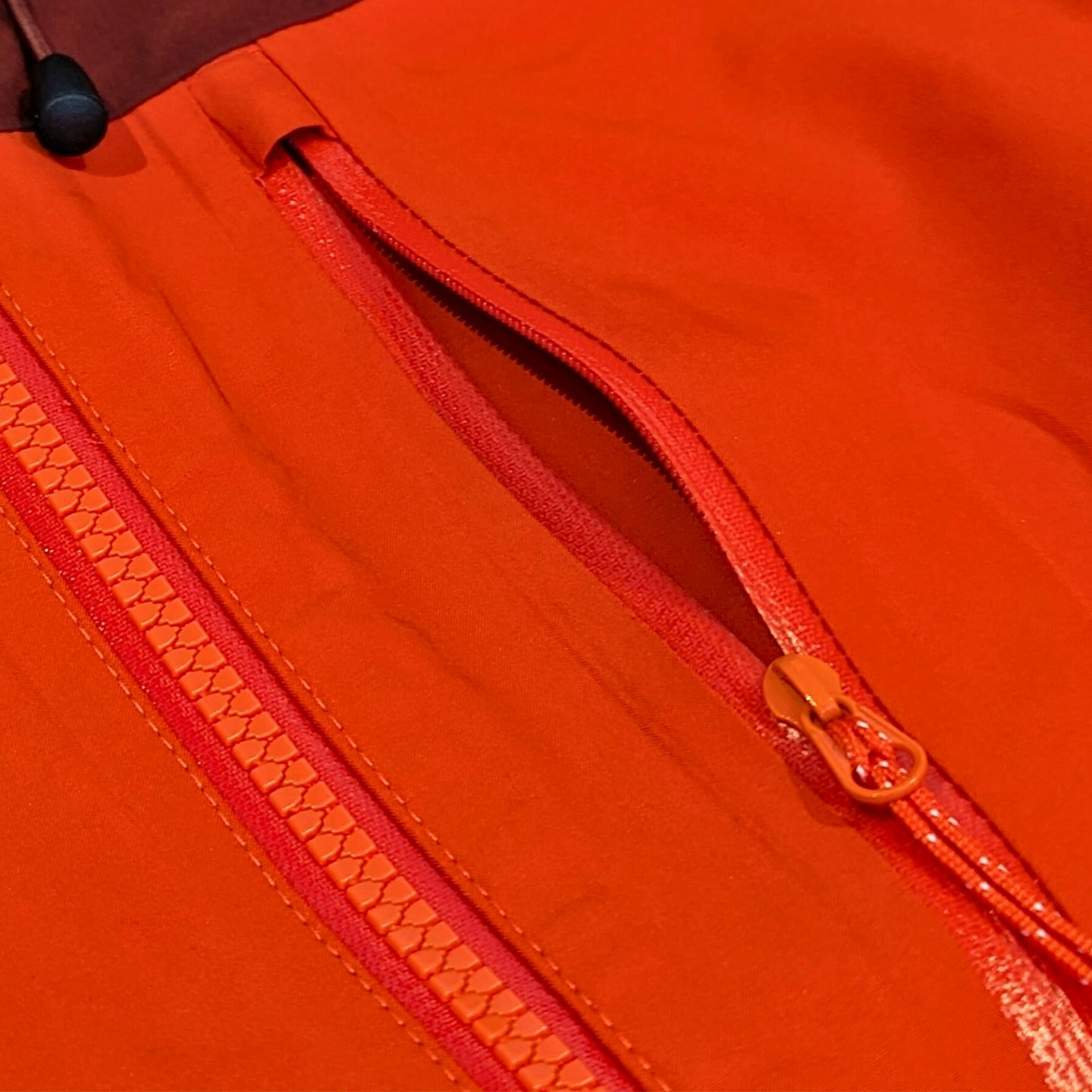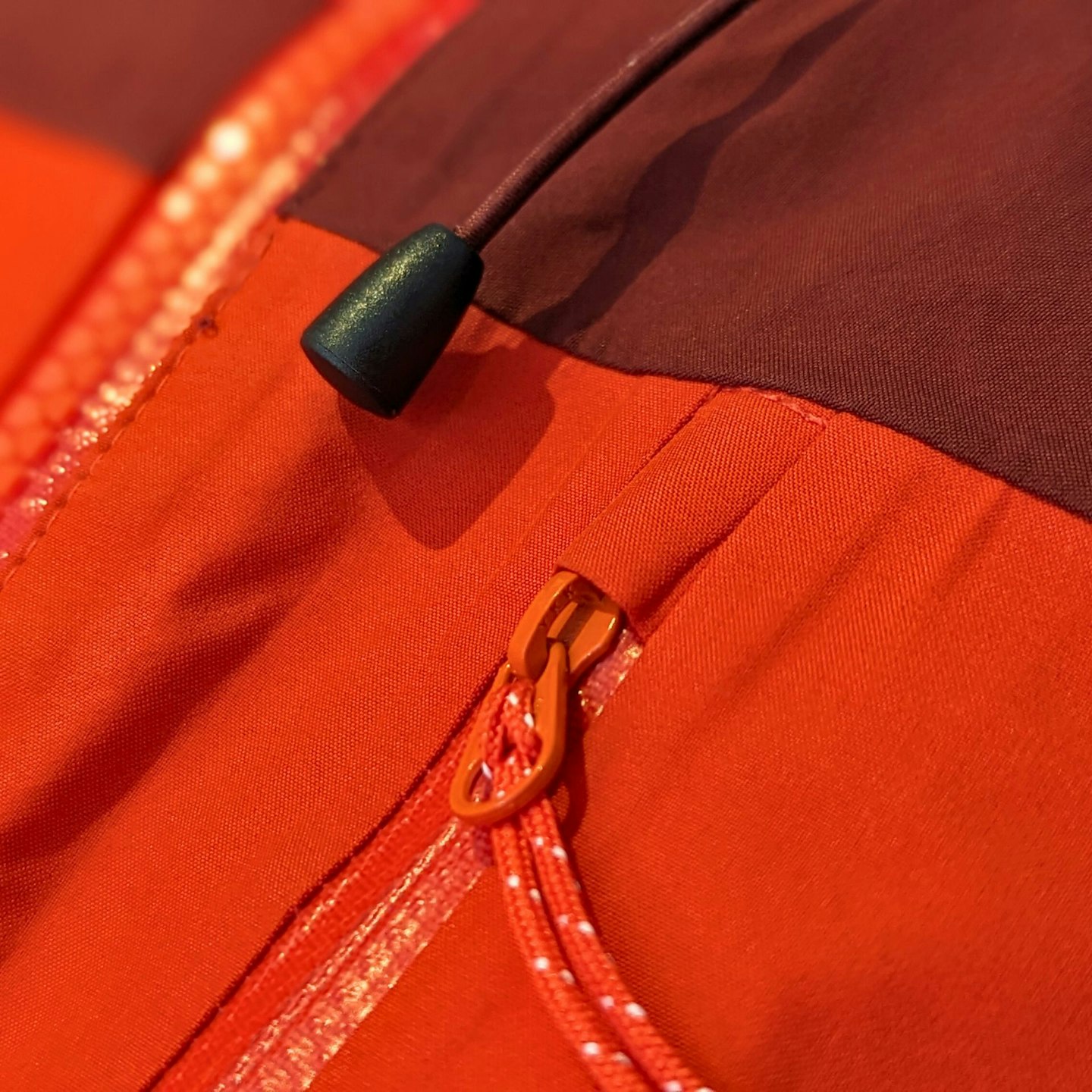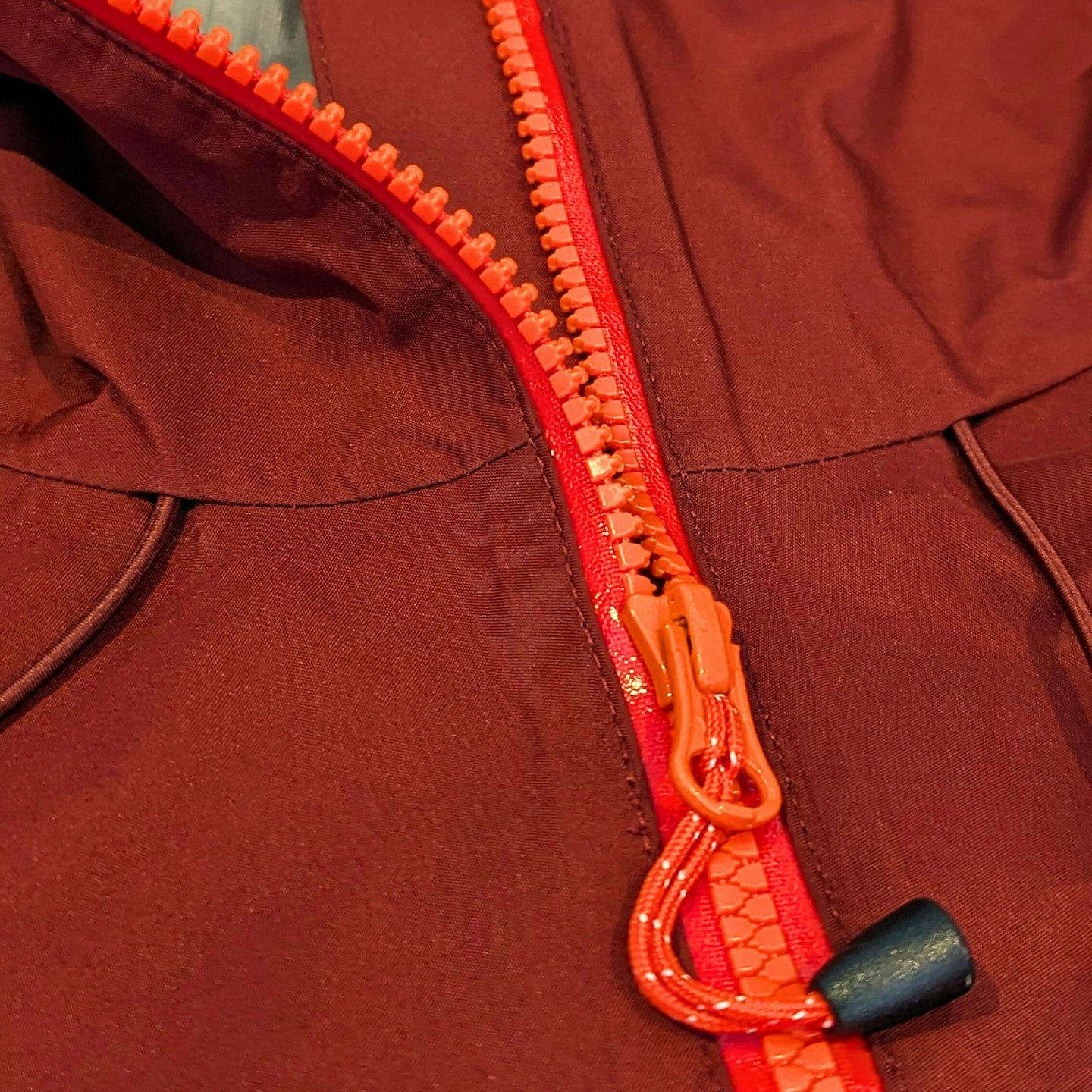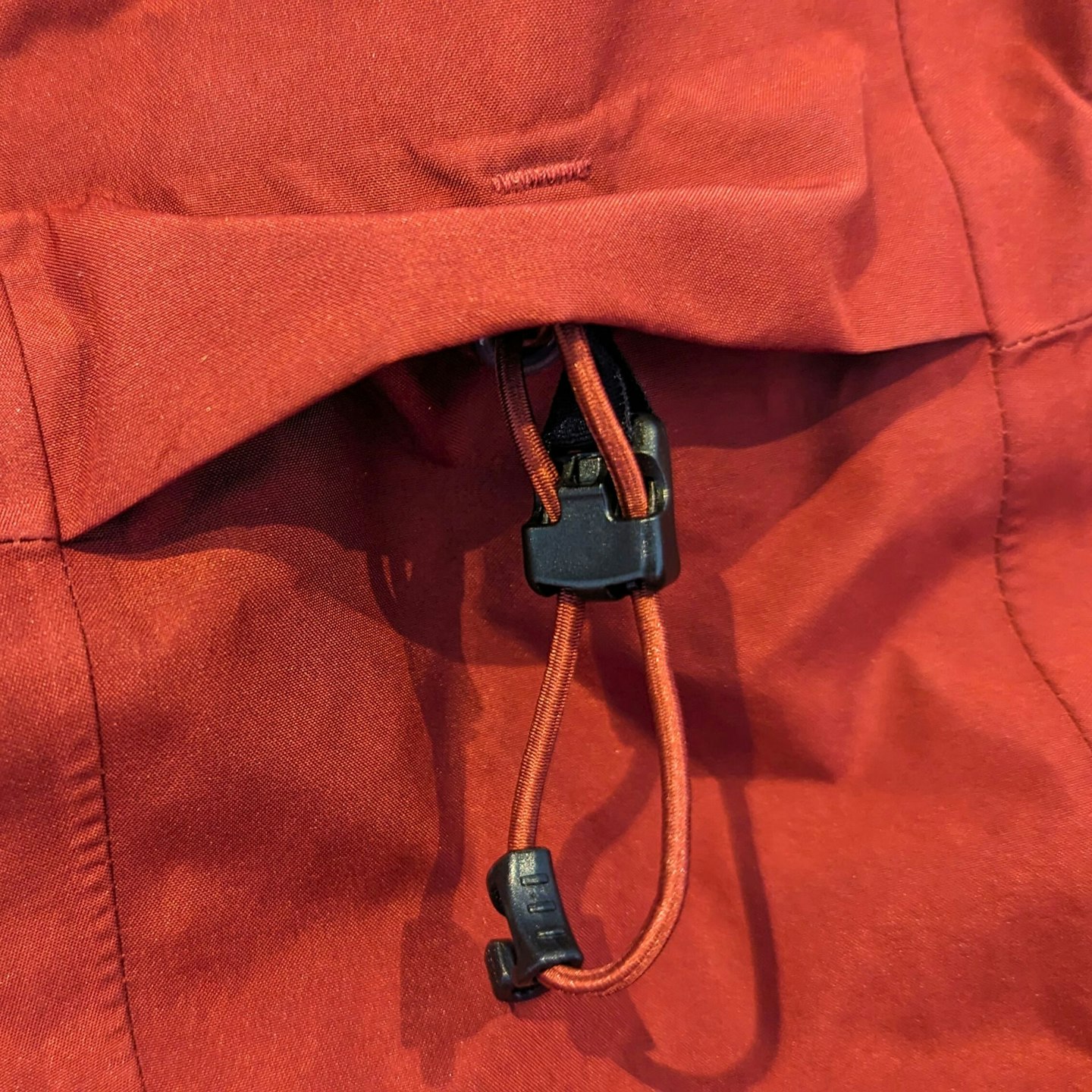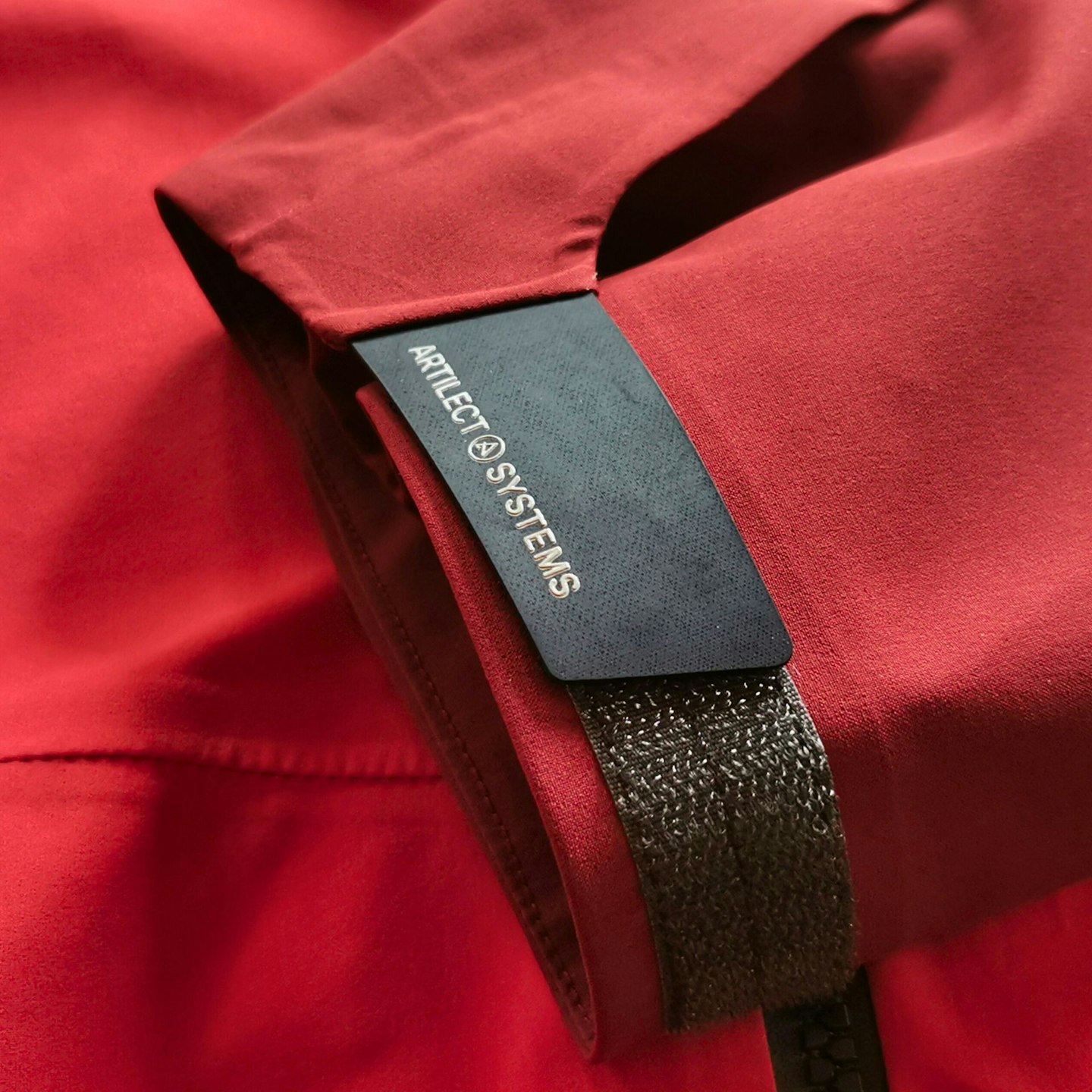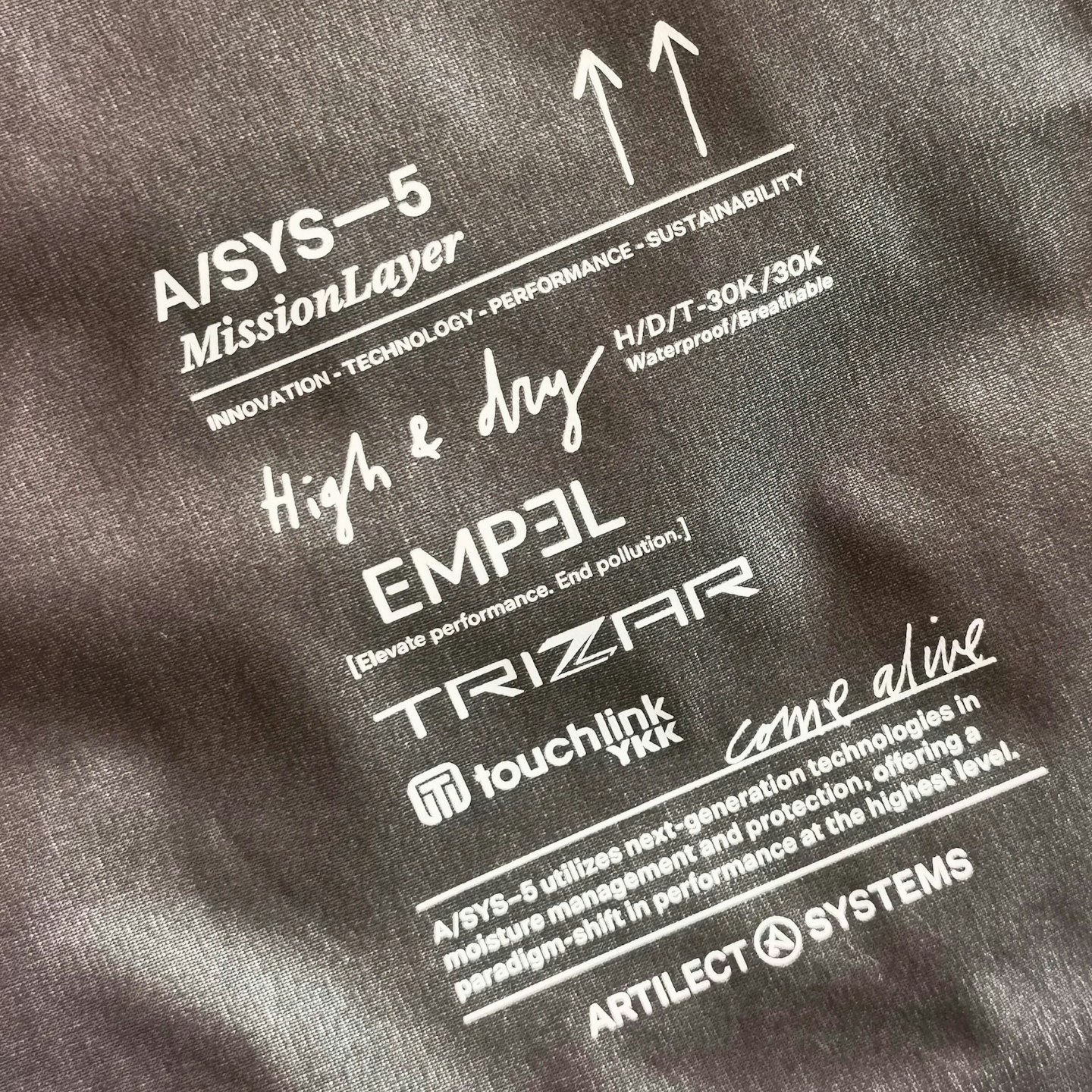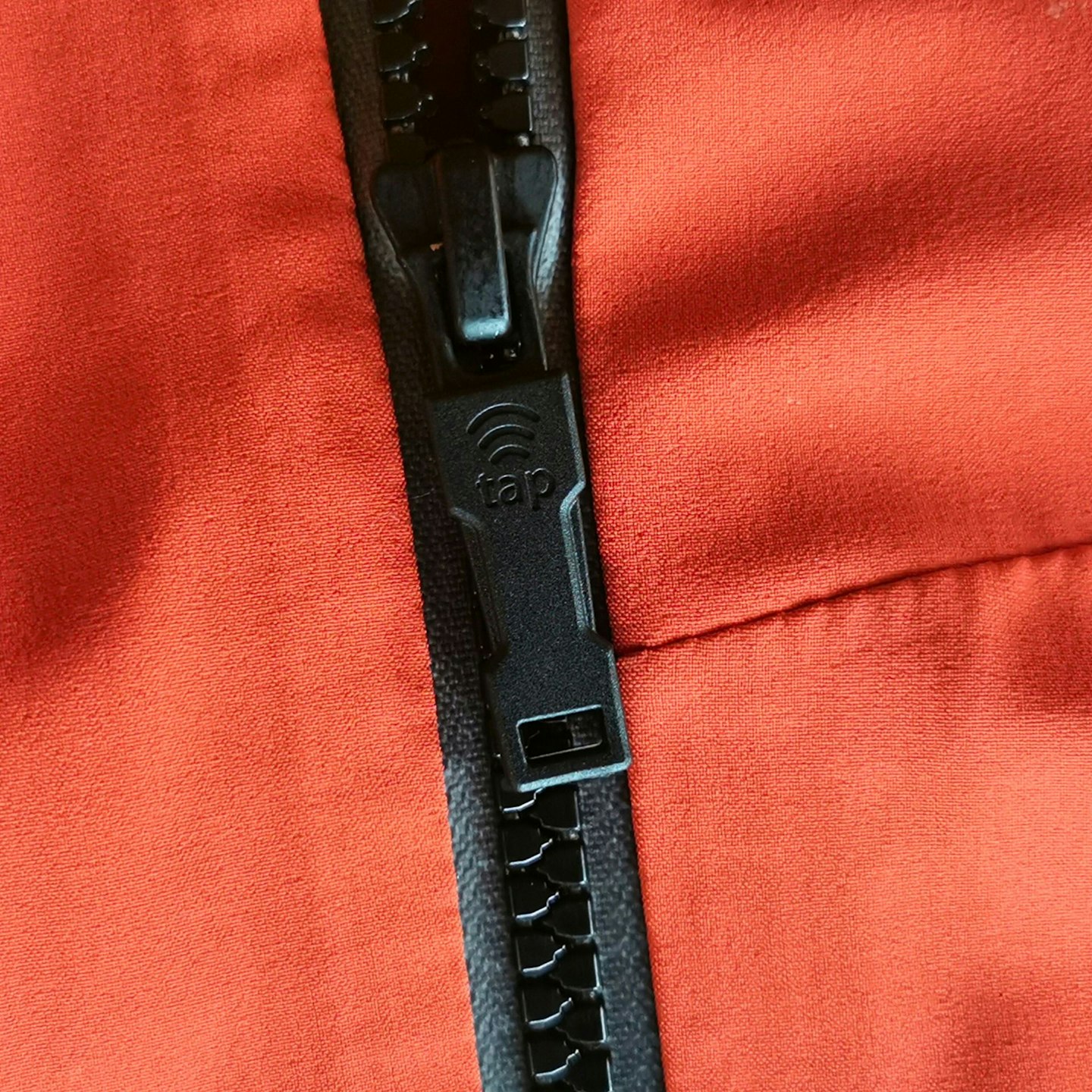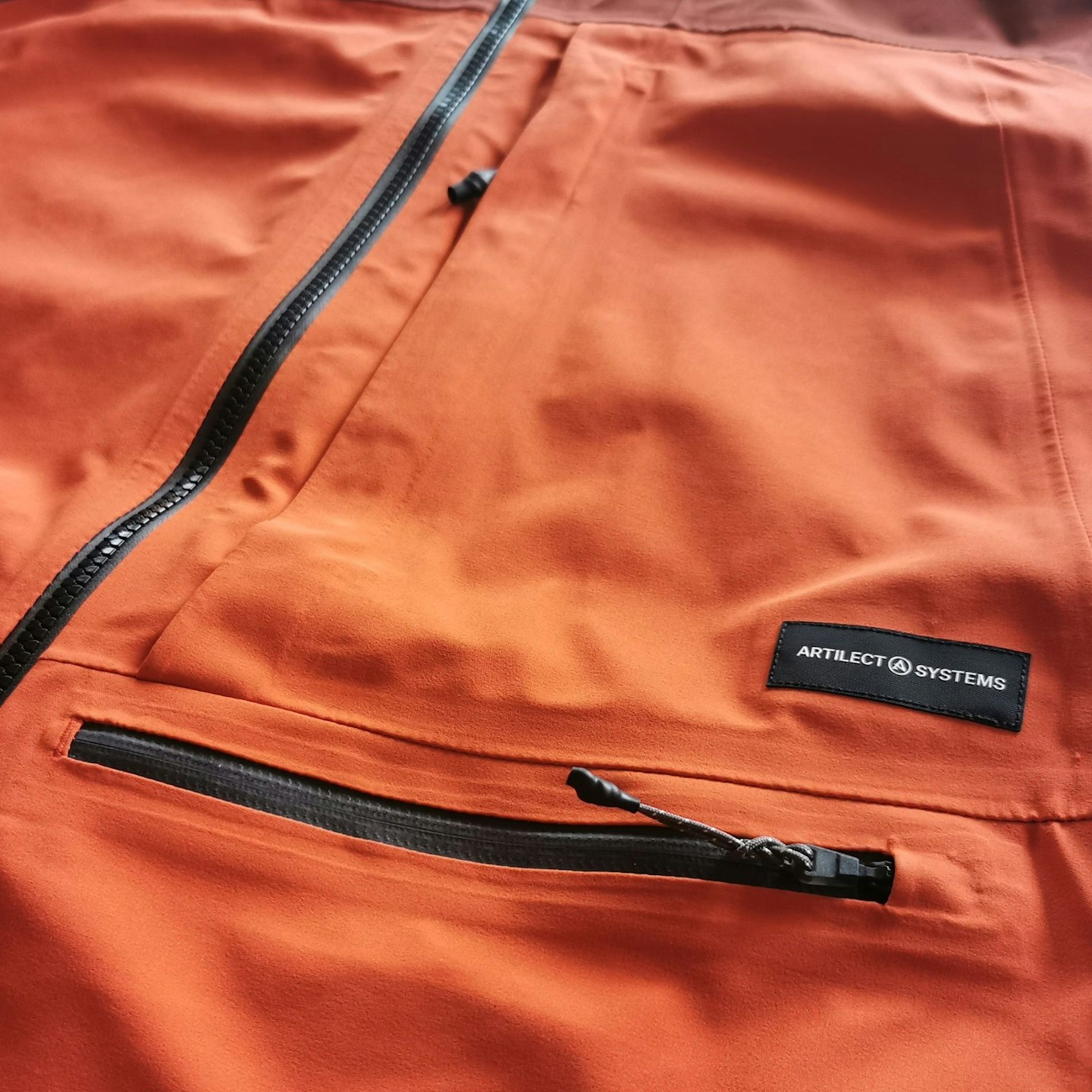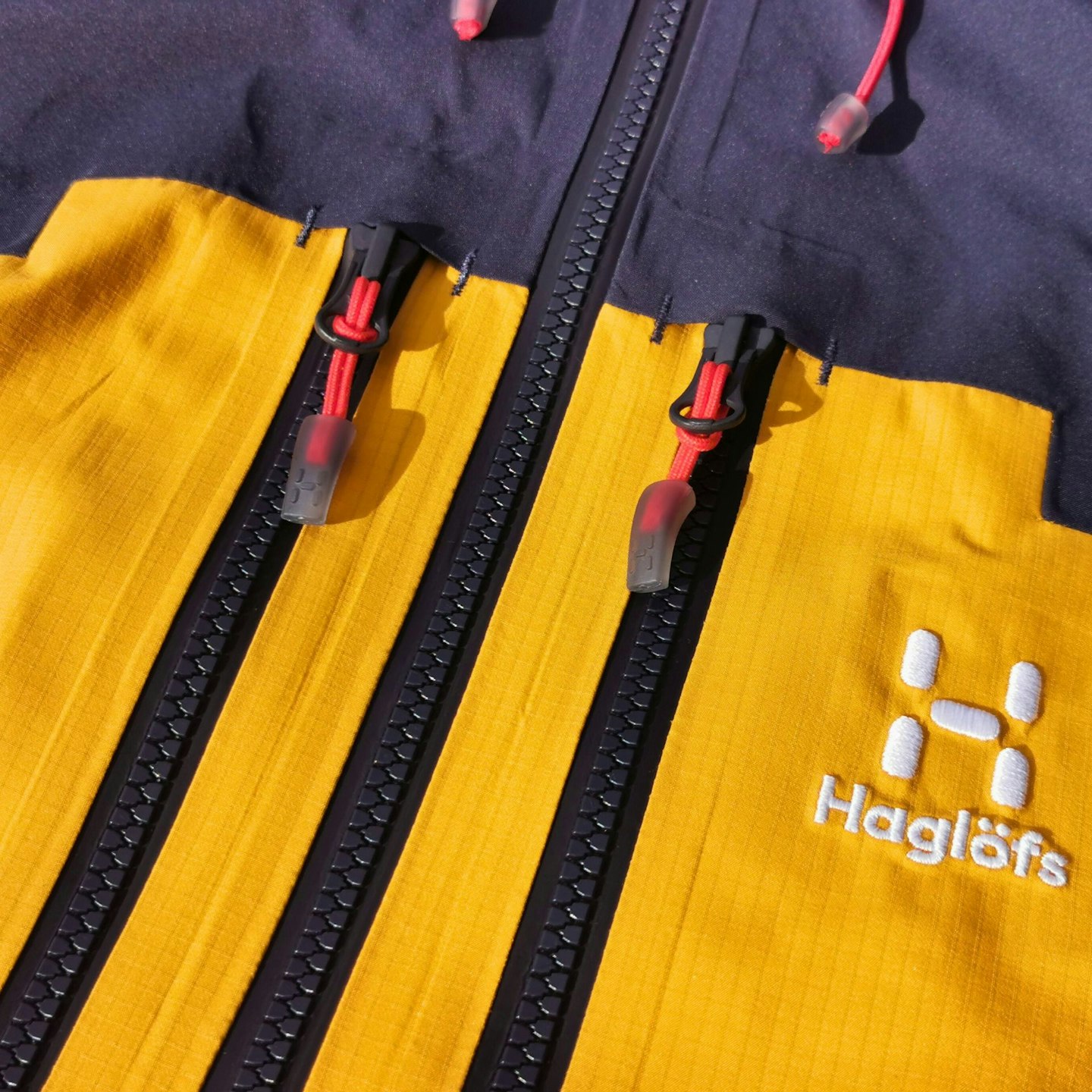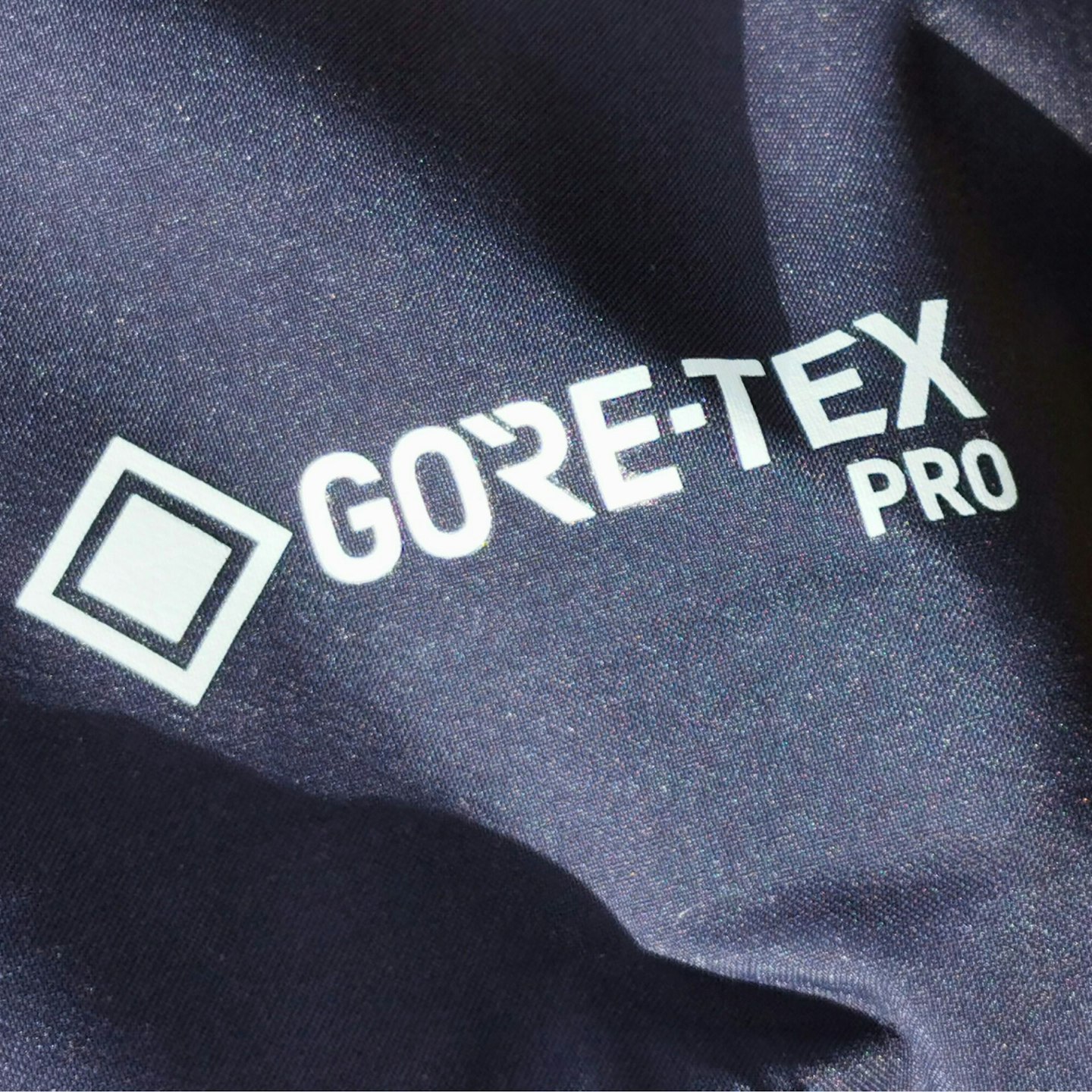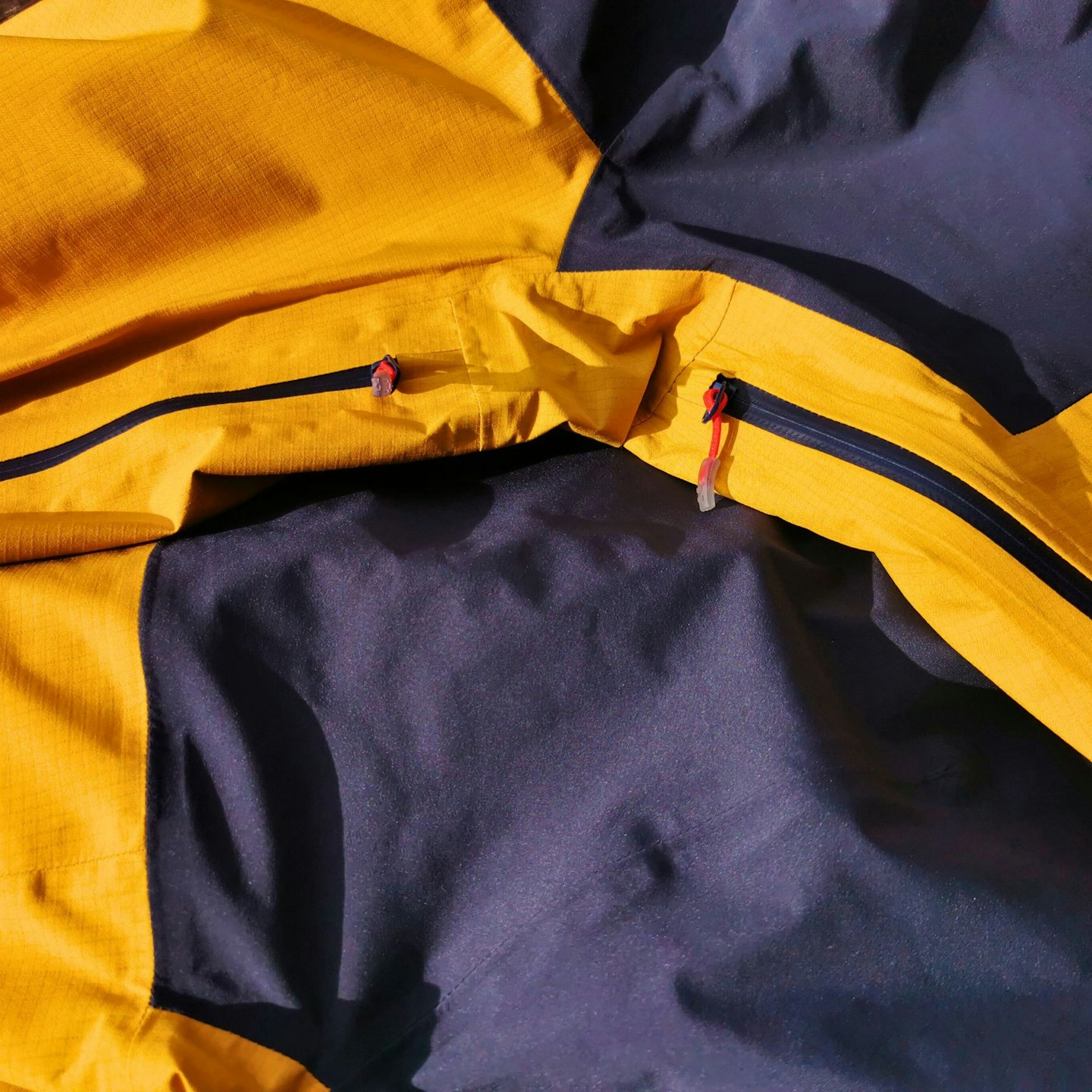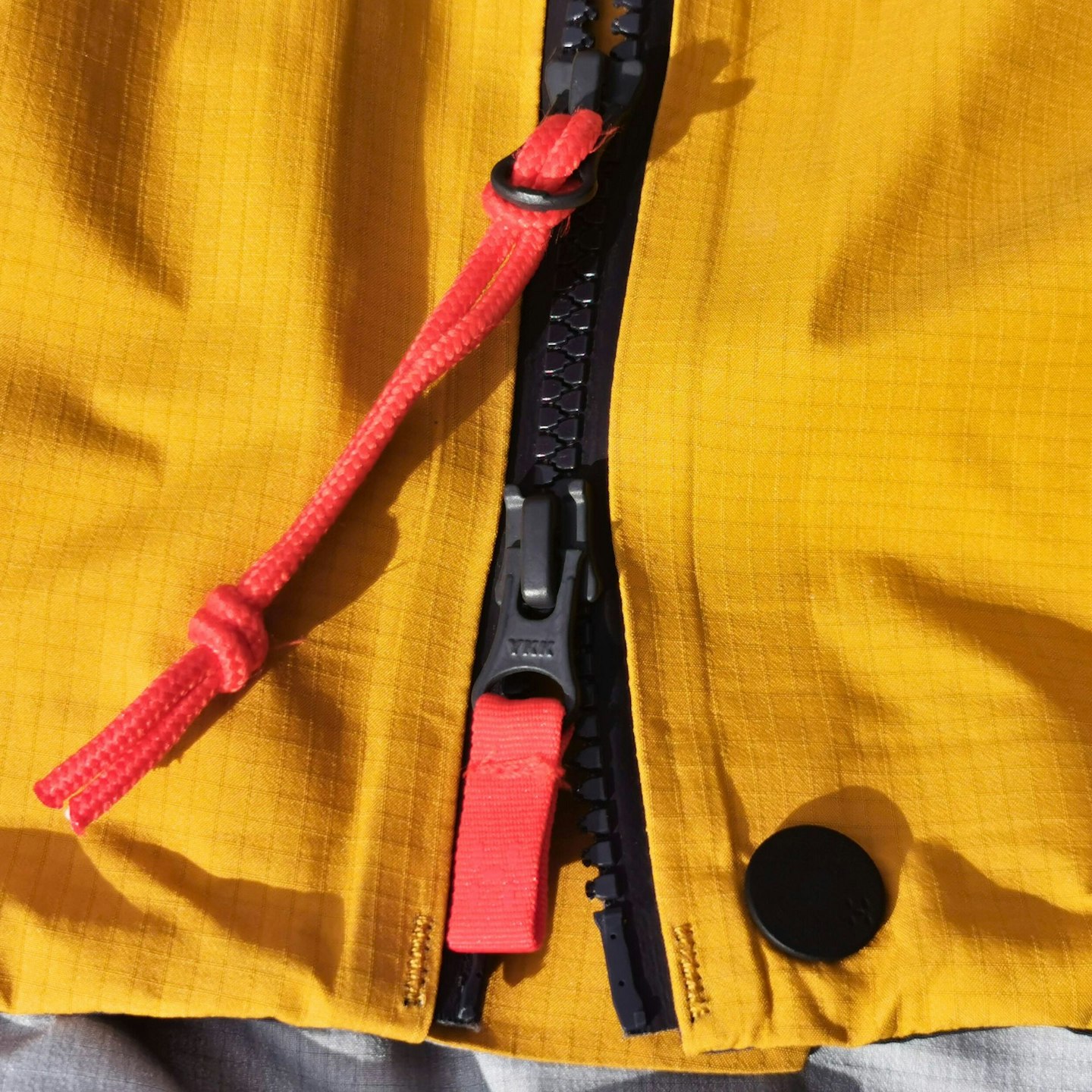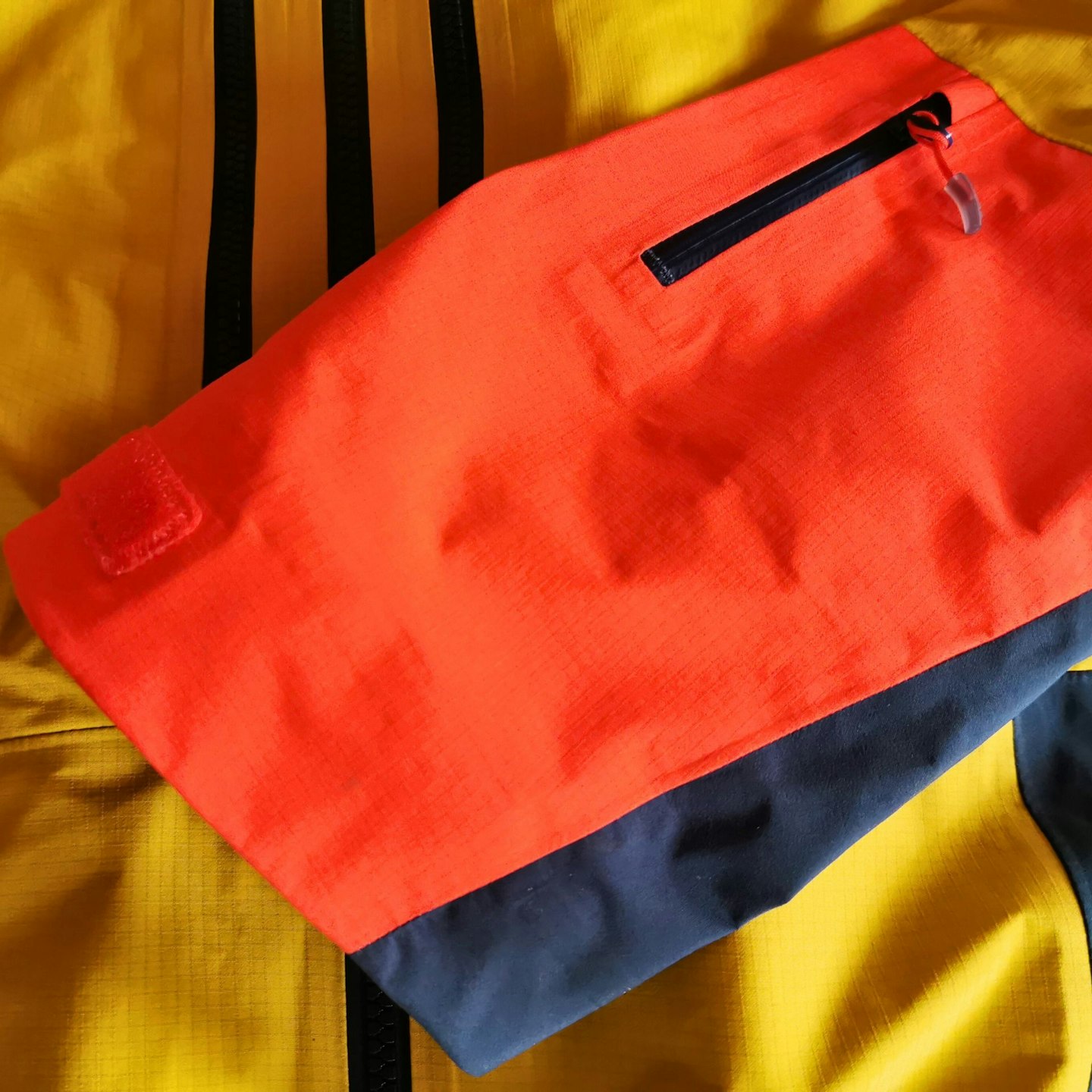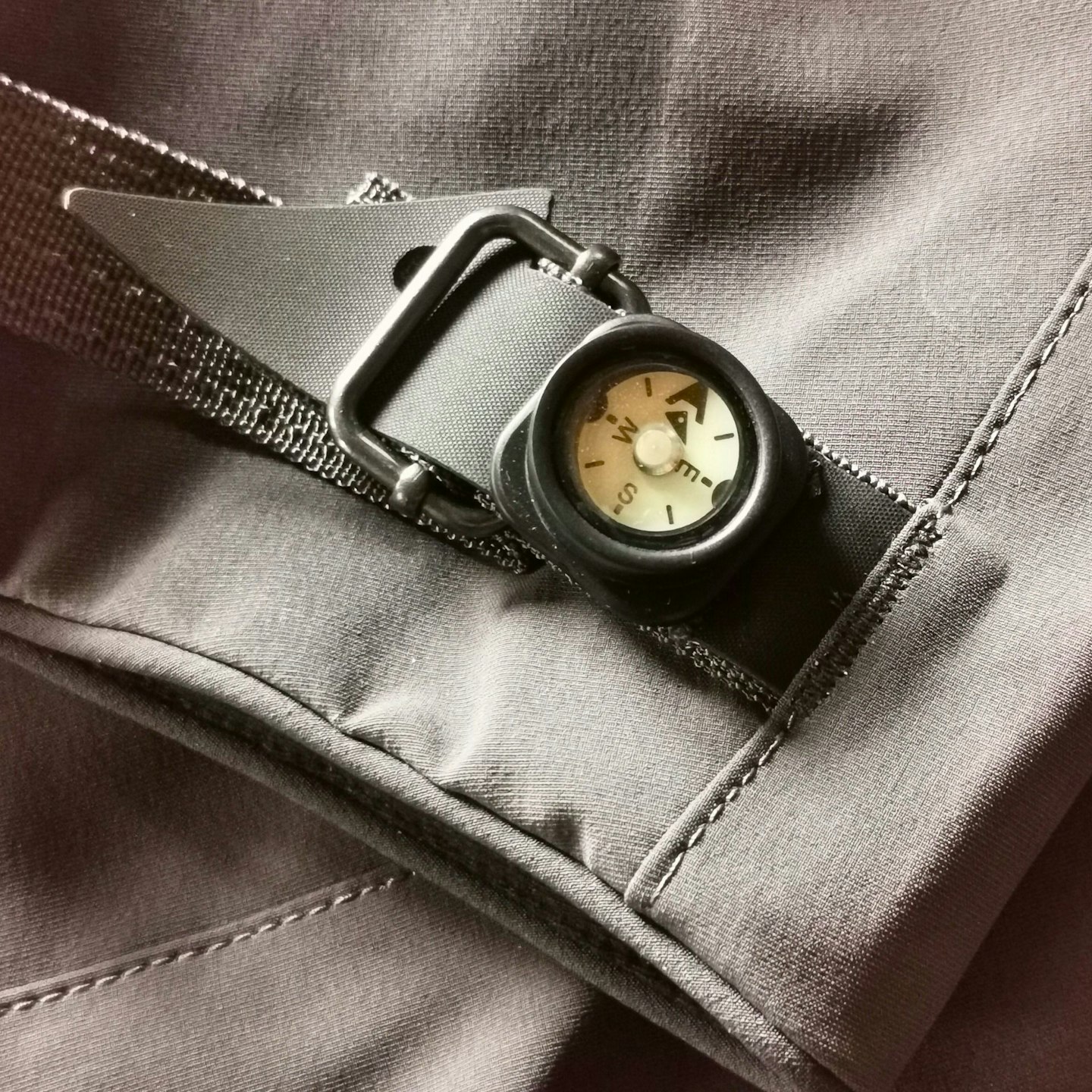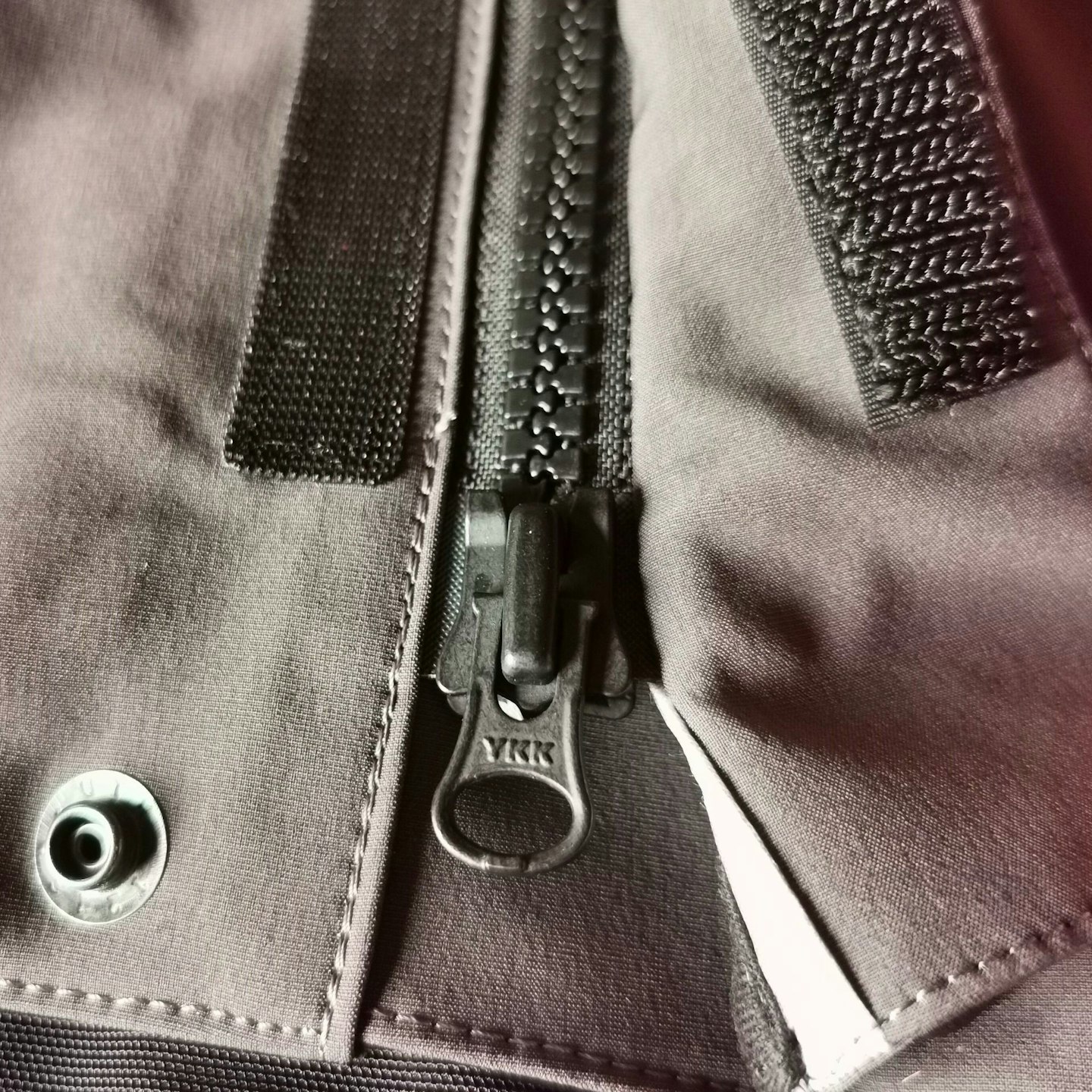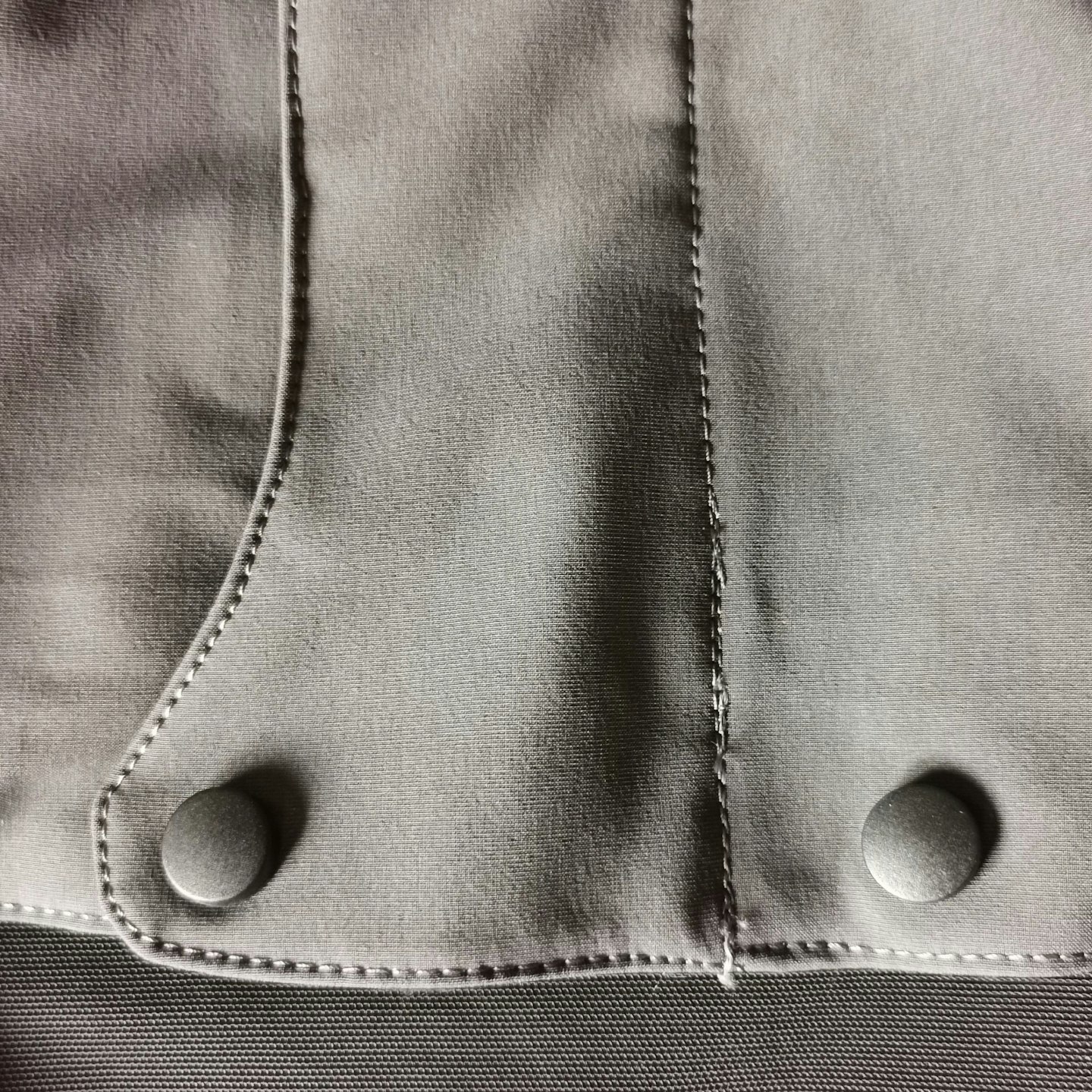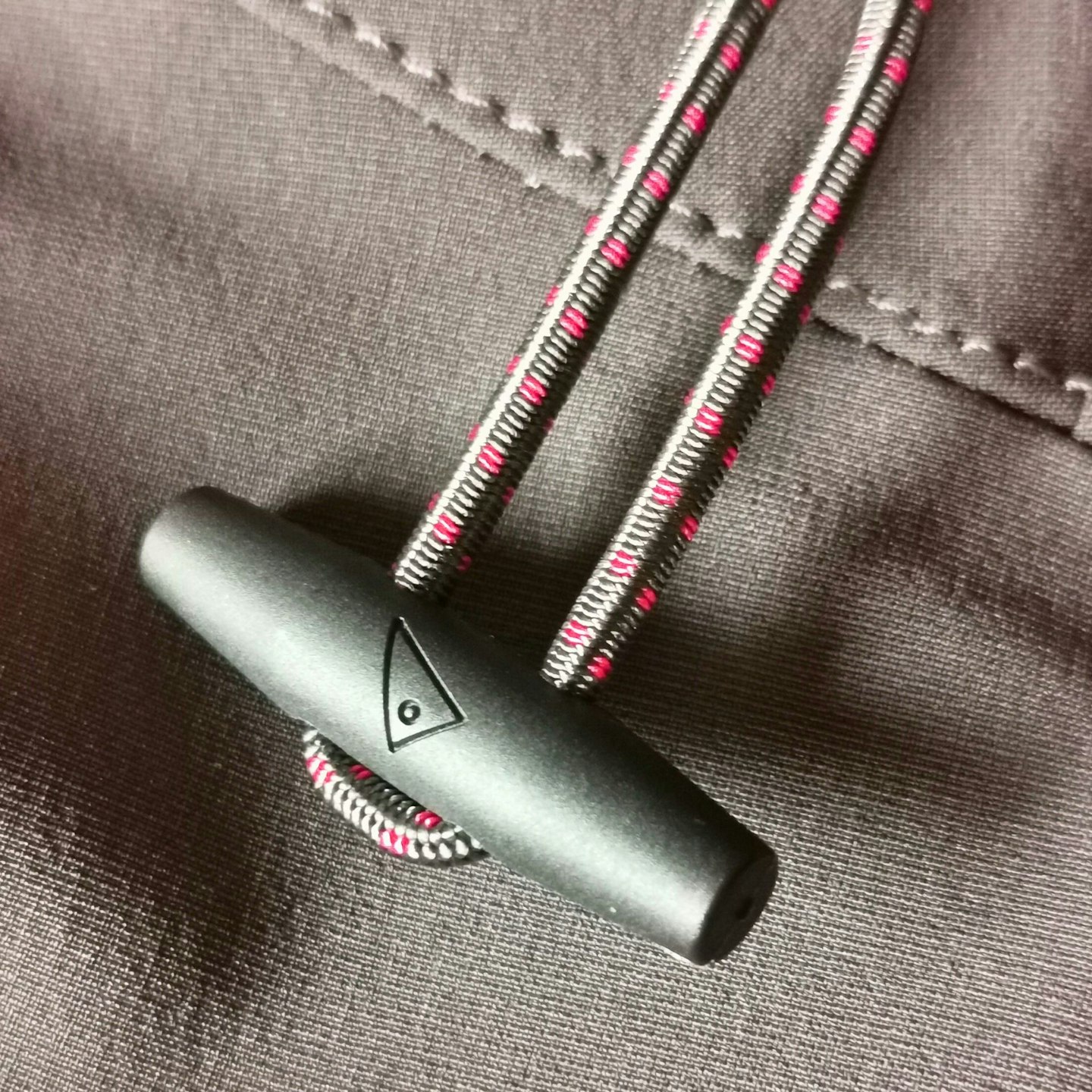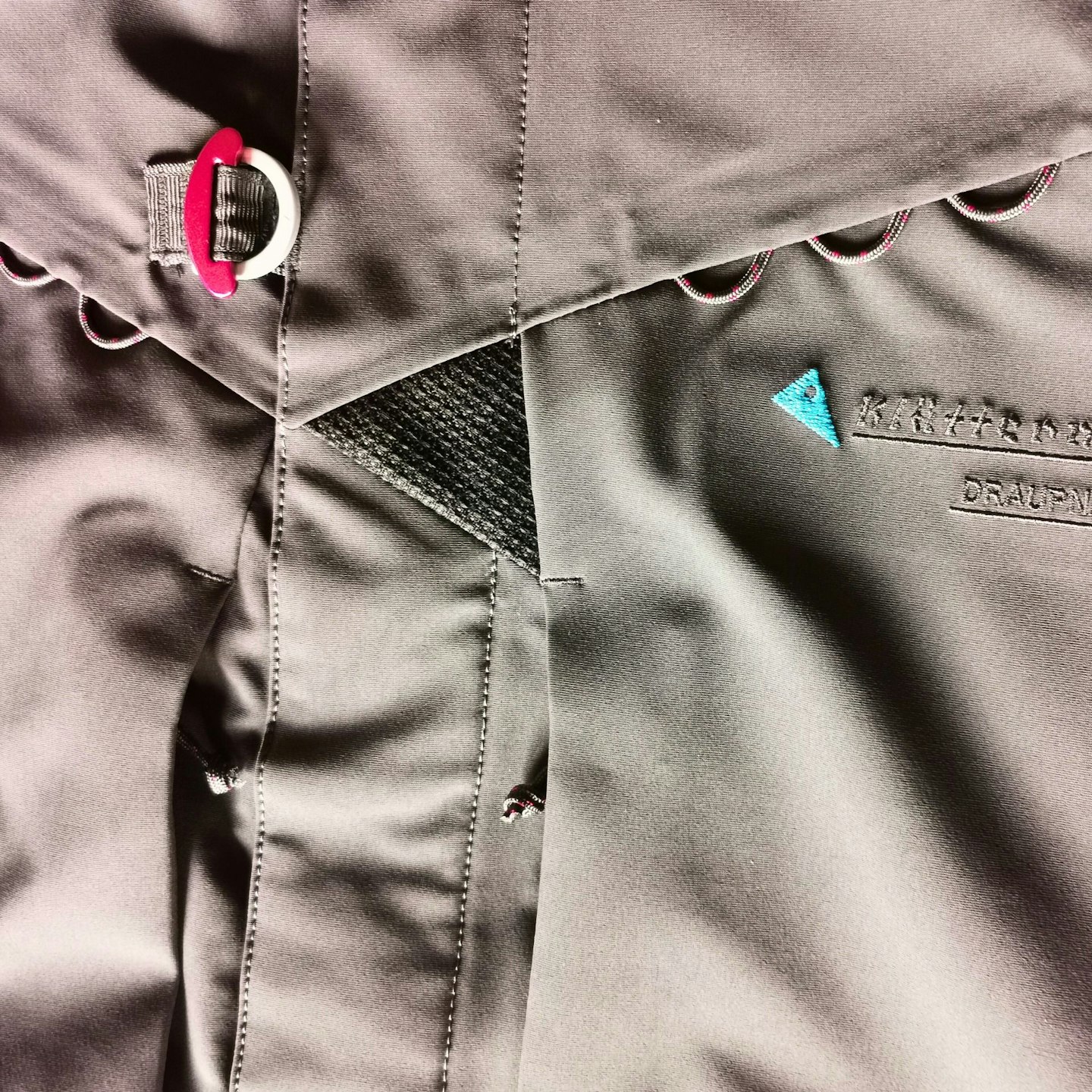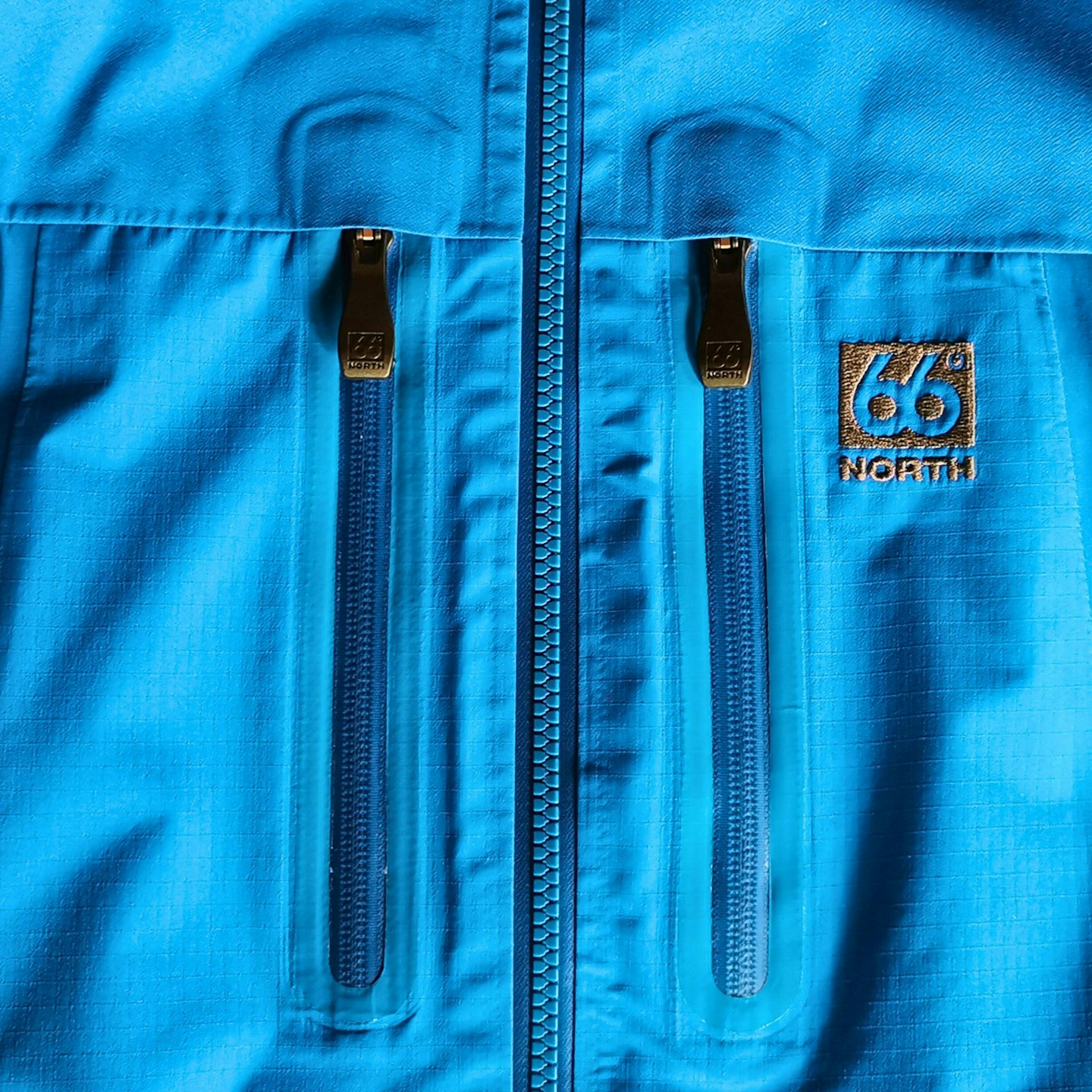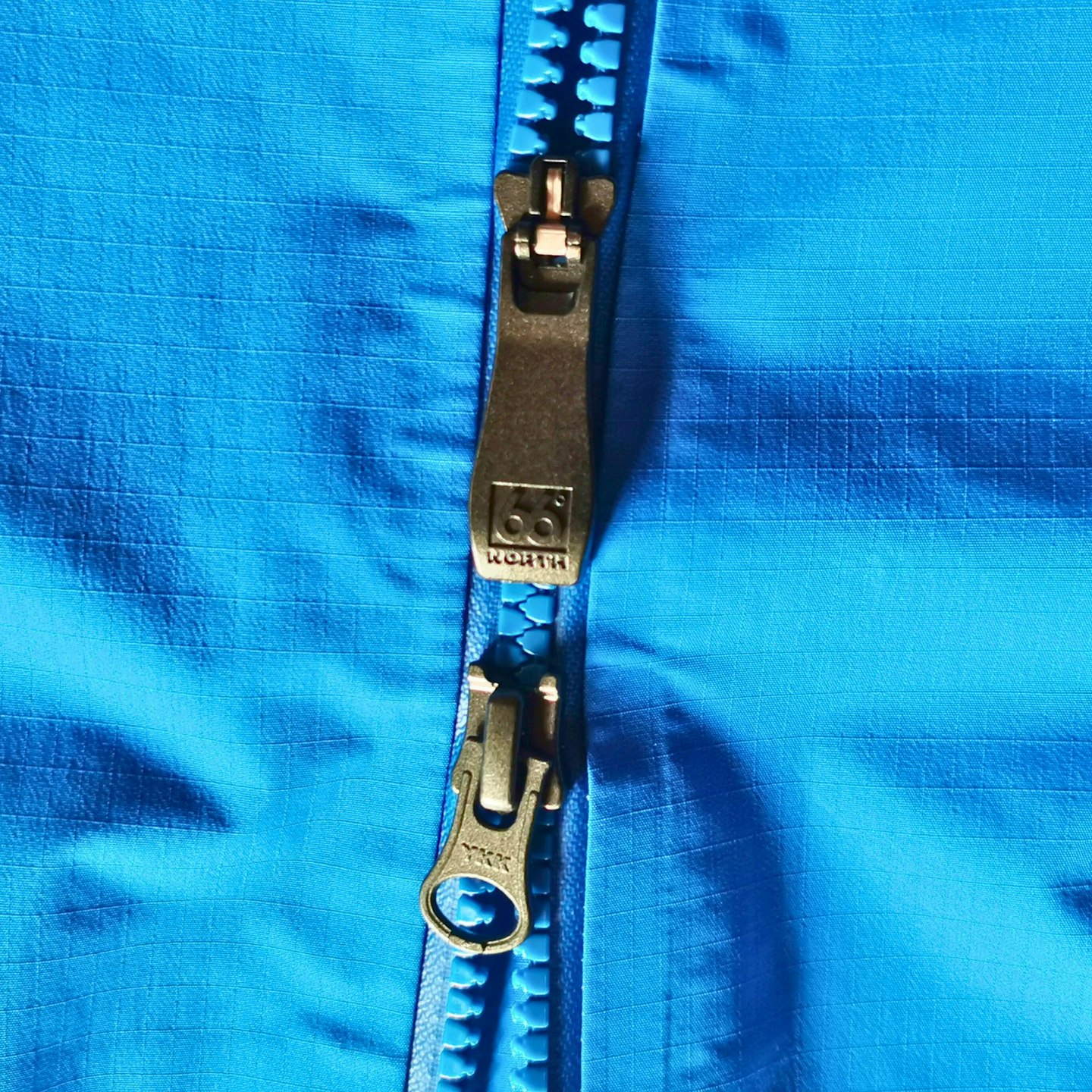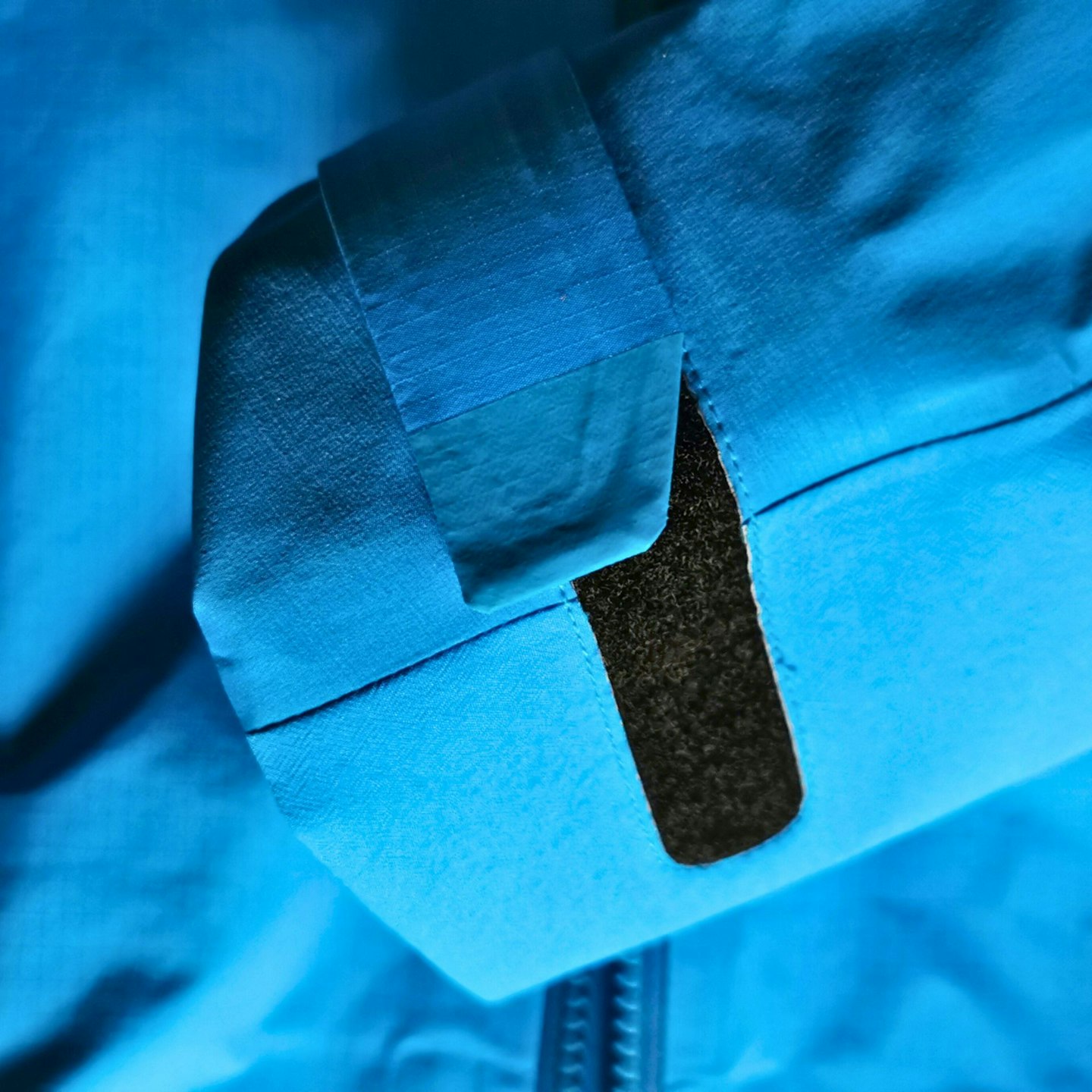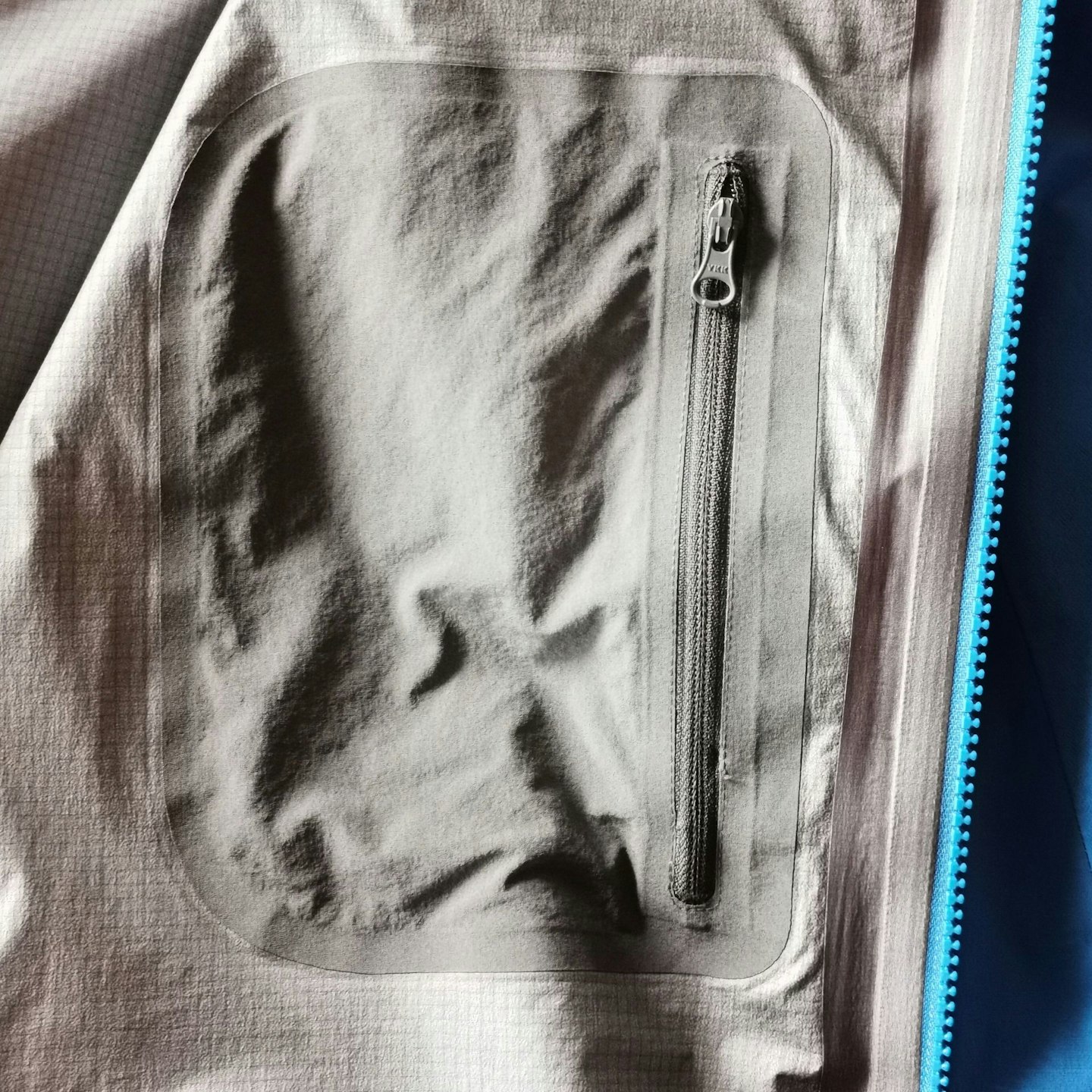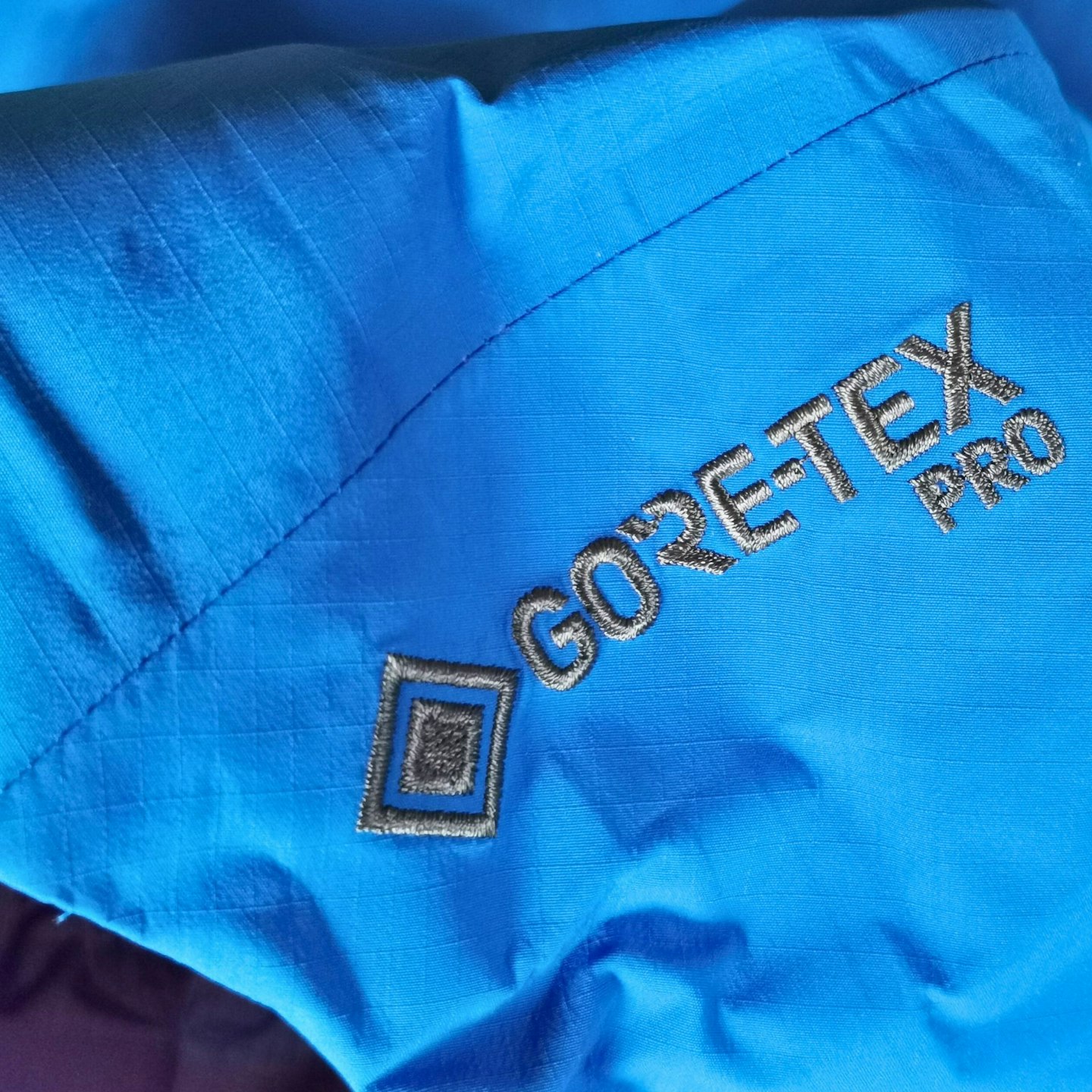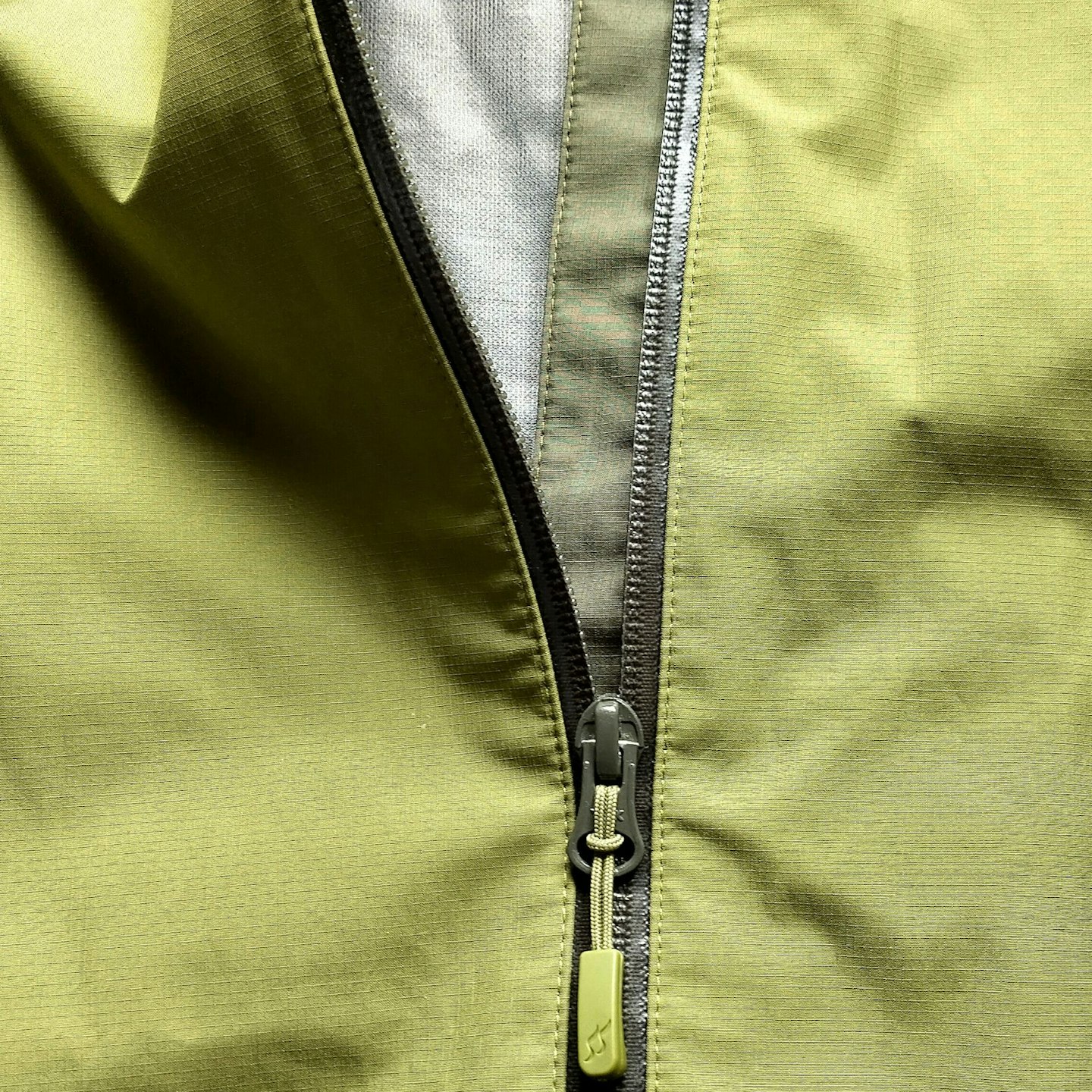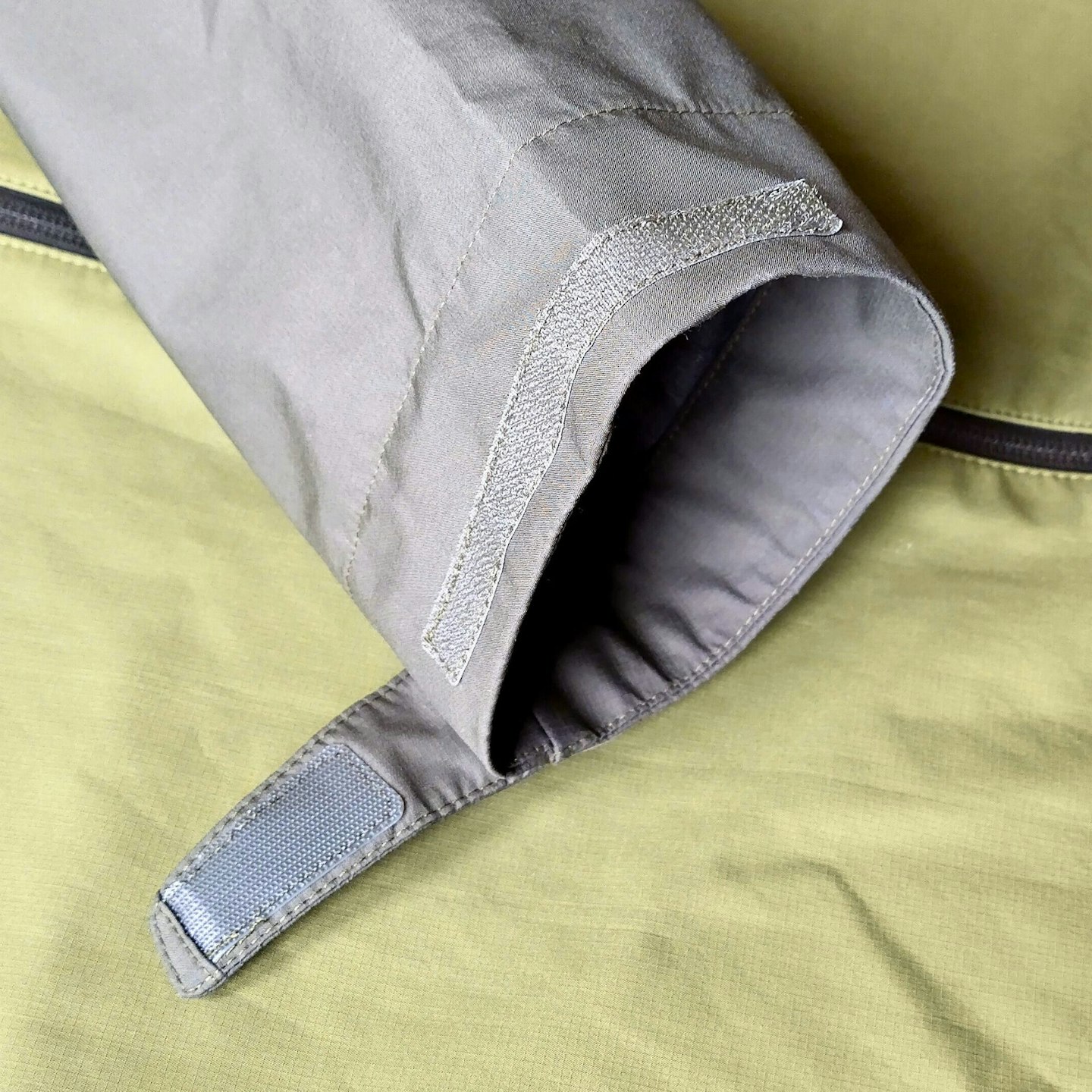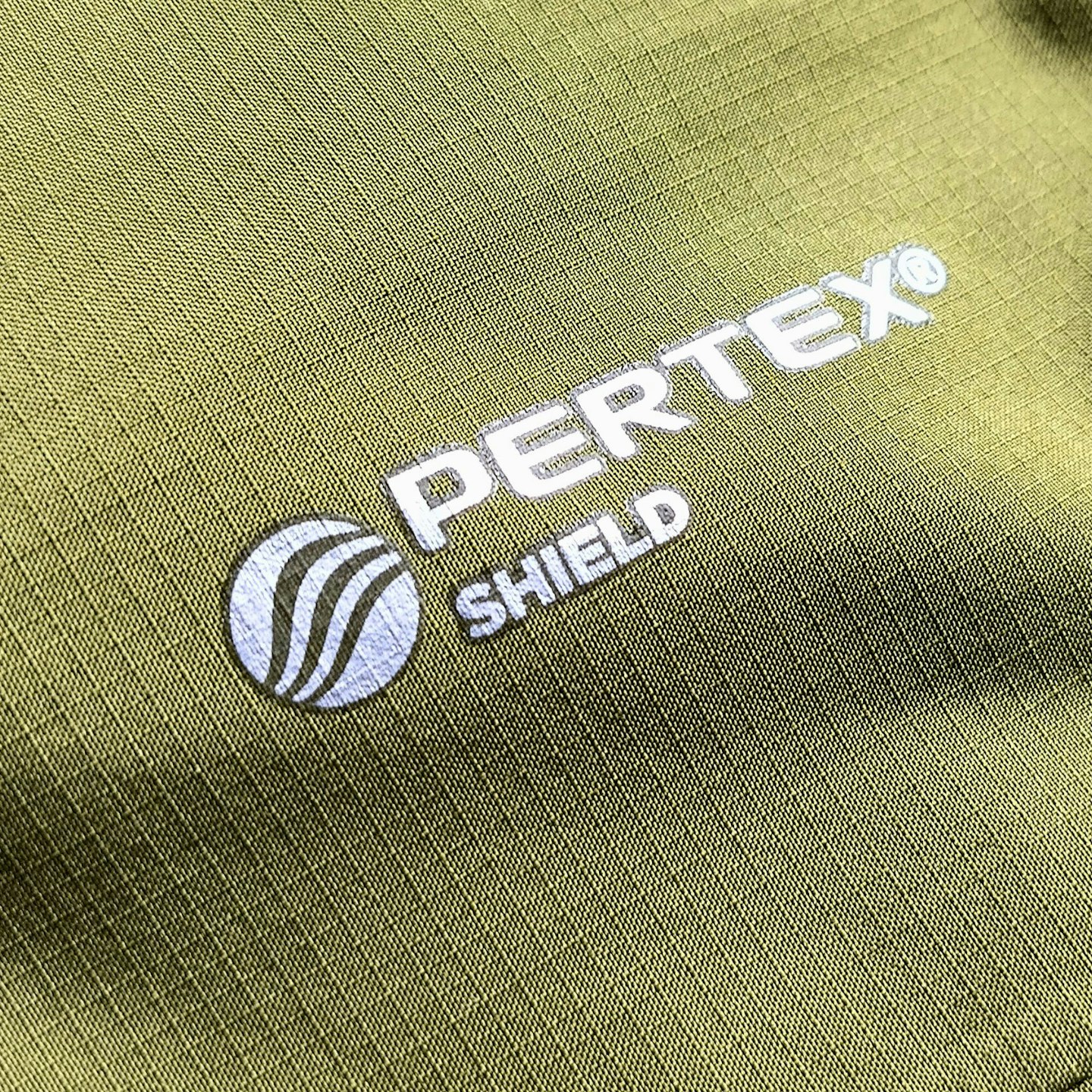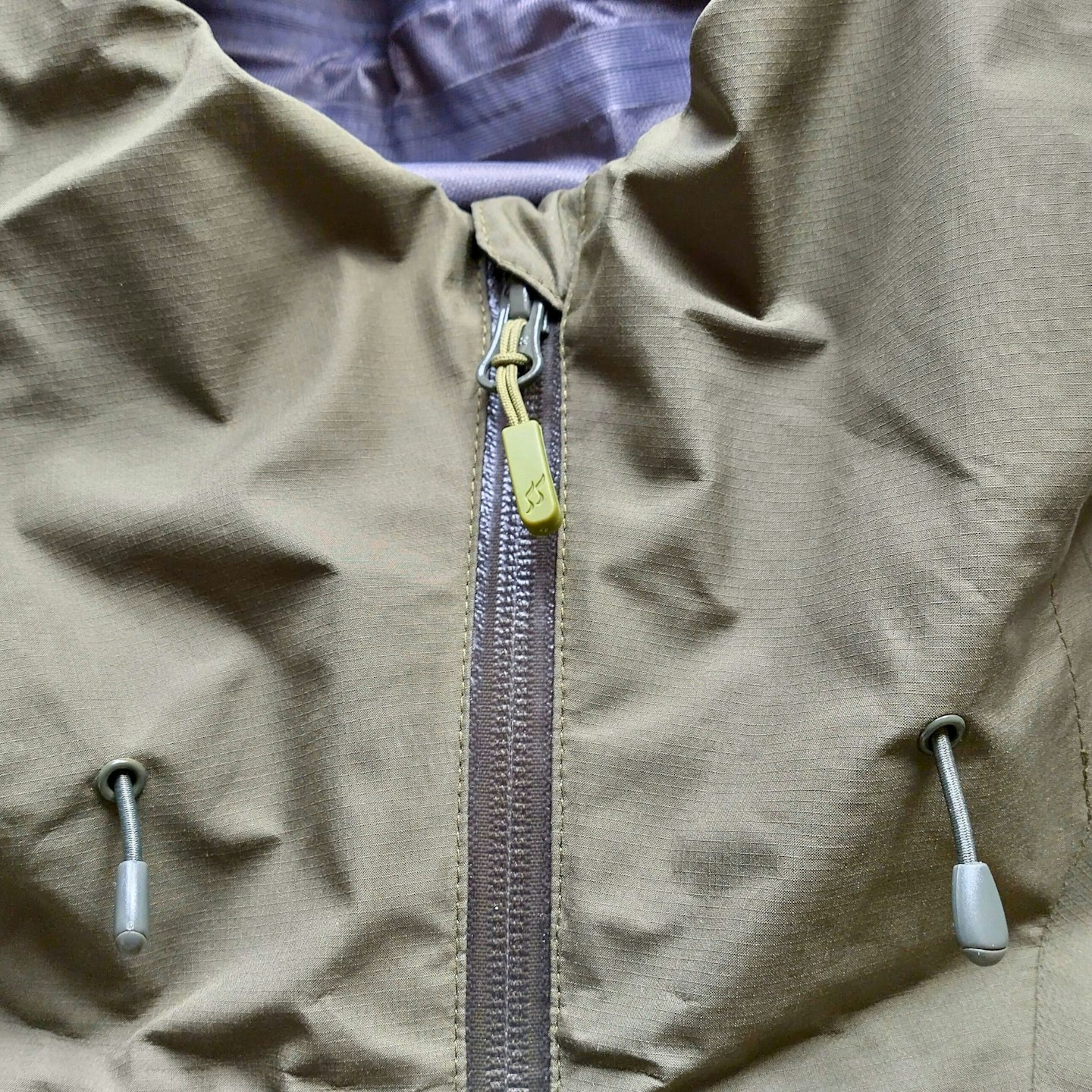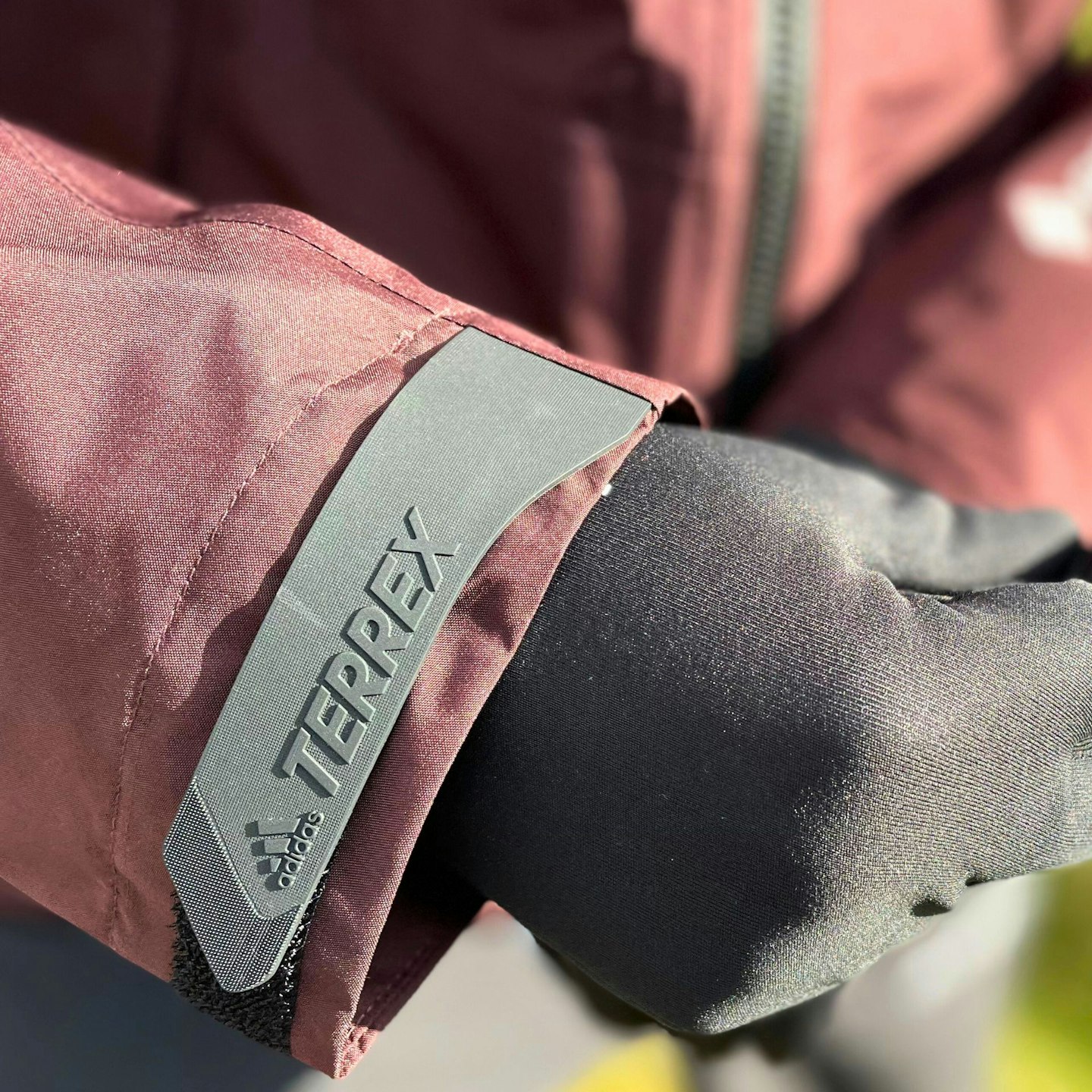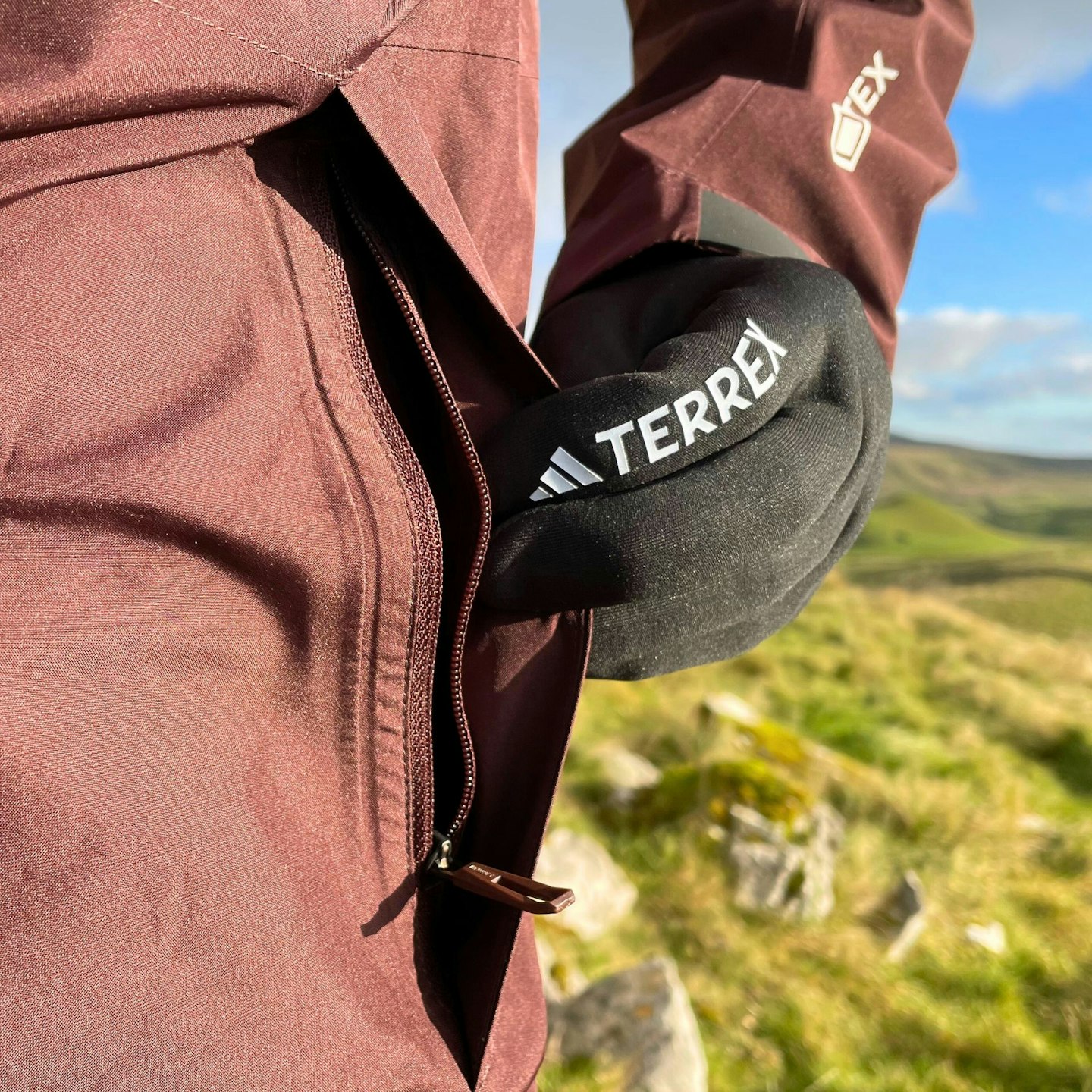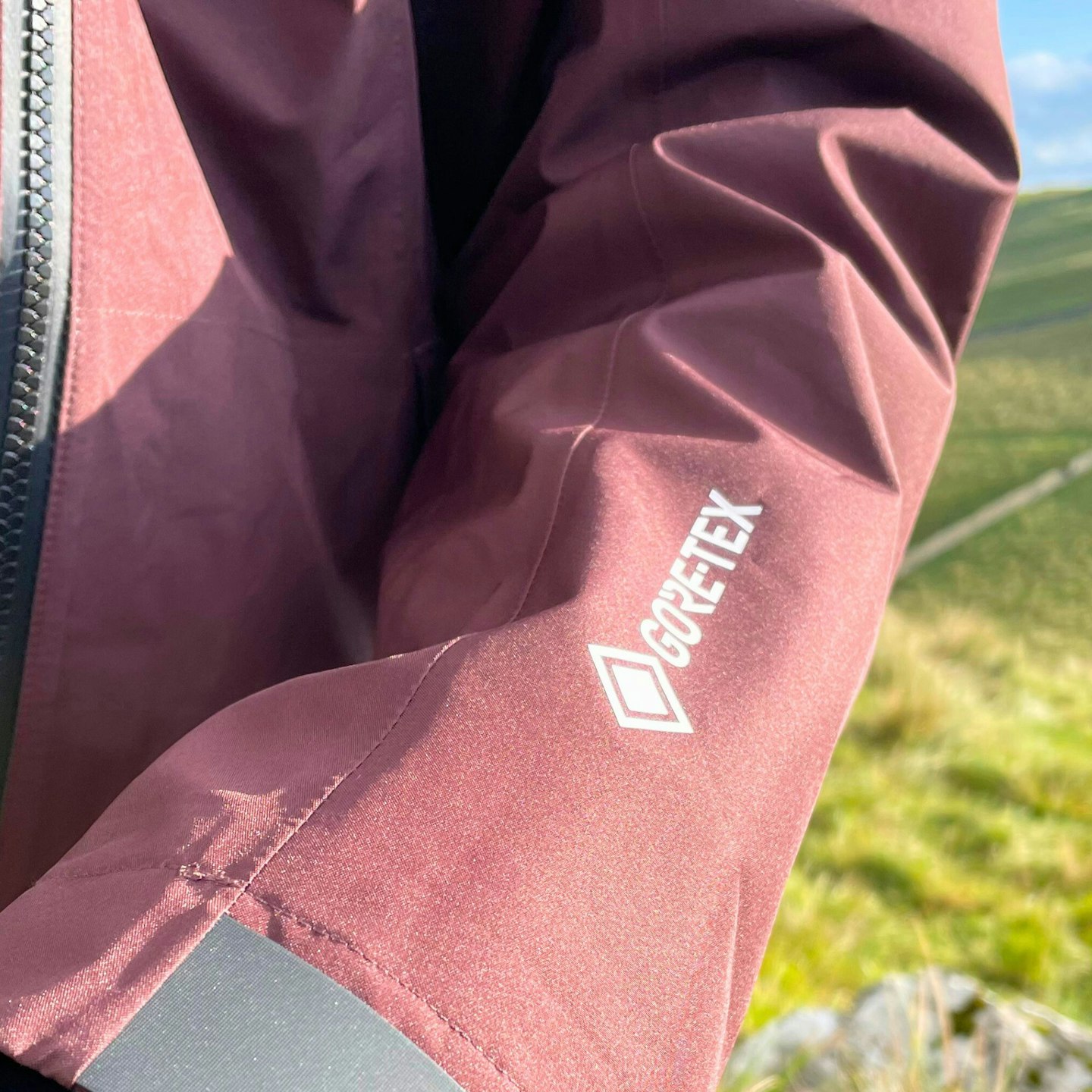When winter rolls around, mountains can become a battleground: walkers vs weather. You’ll typically experience precipitation in all its forms – rain, hail, sleet and snow – and sometimes all in one day. Which means your winter waterproof jacket becomes far more than just an emergency layer.
Your first line of defence in the battle against the elements should be a rugged and reliable waterproof jacket.
Normally worn all day, it should be able to take a fair bit of winter hammering. It should also offer good all-round coverage, including a secure hood, hem, and cuffs that will stay put even in the wildest weather.
Other useful features include easy-access pockets and pit zips to dump heat fast. And if you’re making the transition from winter hillwalking to graded scrambles or climbs, you’ll want a jacket that fits neatly under a climbing harness, plus a hood that will accommodate a helmet.
These premium winter-ready features don’t come cheap, but get all those elements right, and you’ll have a fortress of a jacket that will see you right through to spring.
What are the best winter waterproof jackets of 2025?
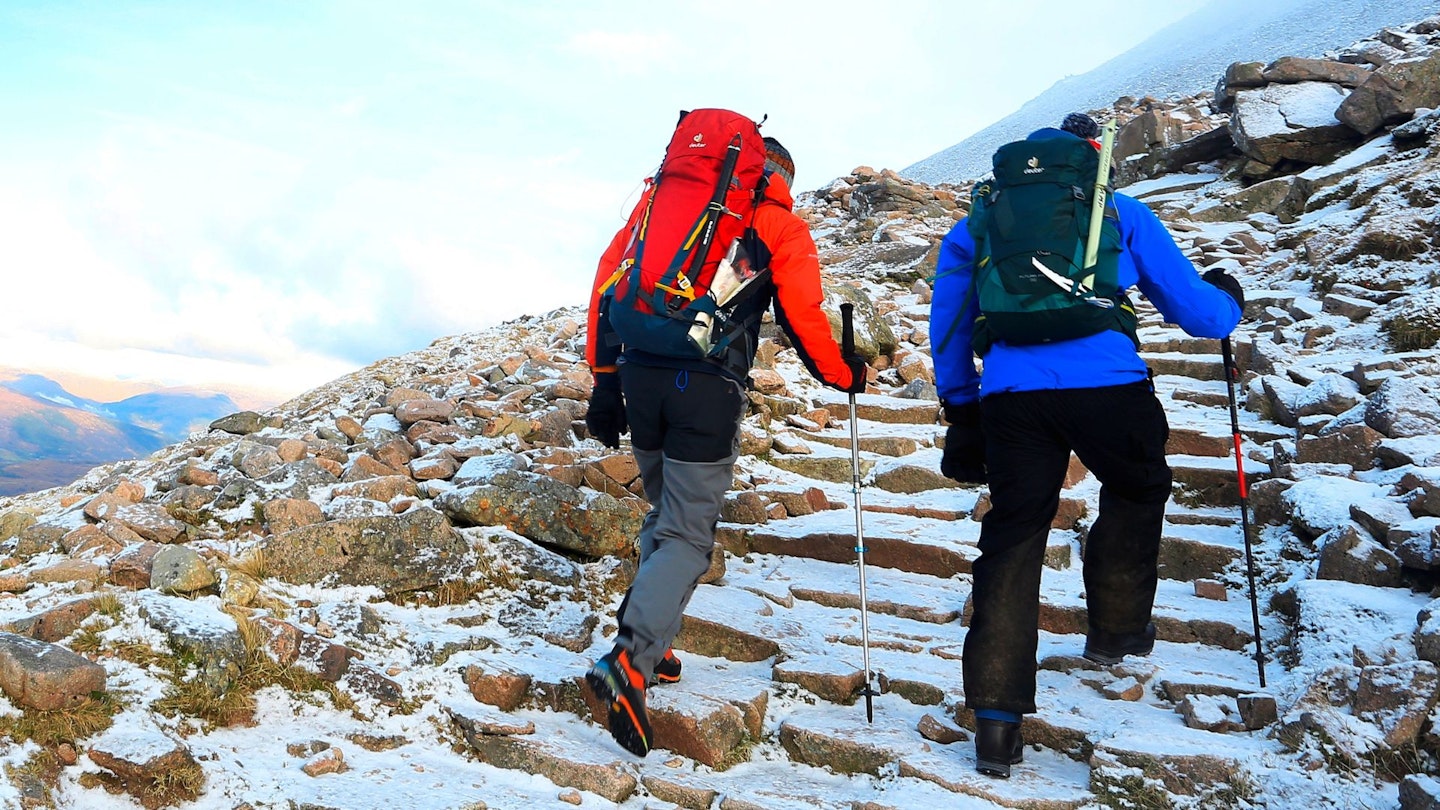
These are the best winter waterproof jackets, as picked after extensive field testing.
Best in test: Mountain Equipment Lhotse
Best value: Mountain Equipment Makalu
Best technical winter waterproof: Haglöfs Spitz GTX Pro
How we tested the best winter waterproof jackets
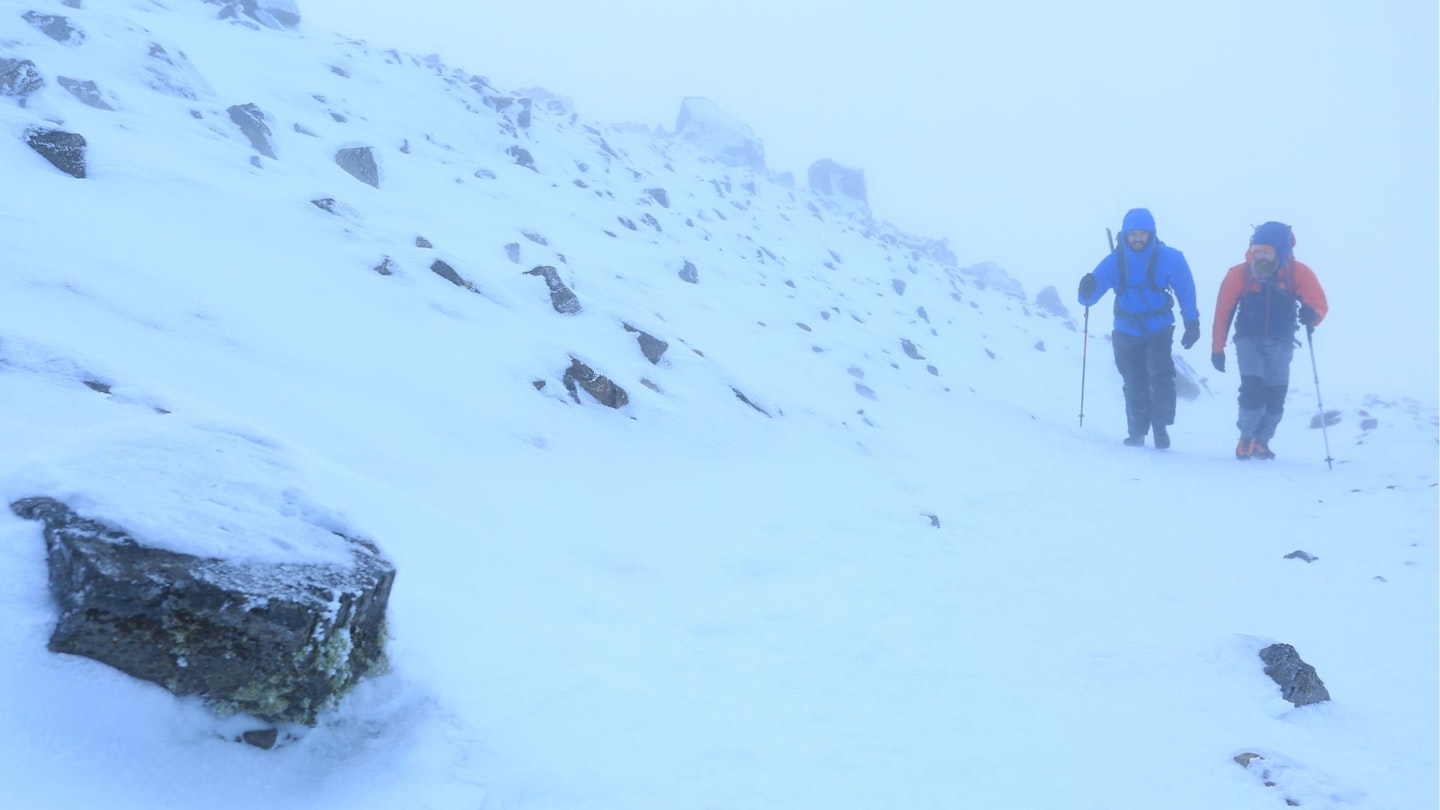
The testing of the winter waterproof jackets featured below was done by Matt Jones and James Forrest.
Matt is a self-confessed gear geek and one of our freelance gear testers. He has walked several long-distance backpacking trails in New Zealand, the USA and throughout the UK.
James is a prolific peak bagger, long-distance walker and gear tester who’s climbed all of the UK and Ireland's 1,001 mountains in a fastest-known time of three years..
When reviewing these winter waterproof jackets, we put them through some very rigorous testing, taking them into harsh, winter mountain conditions to find out how they perform.
Performance, durability and comfort are essential elements of a winter waterproof jacket, but we also looked at how well their features work in real world conditions.
Beyond field testing, we also investigate how the jackets are made and what steps the brands take to ensure they take sustainability as seriously as performance. Read more about we test outdoor gear HERE.
Best winter waterproof jackets reviewed:
The Mountain Equipment Lhotse jacket is a classic among hikers and mountaineers, praised for balancing rugged protection, comfort and weight.
Named after the world’s fourth-highest mountain, it has won multiple awards, including Trail's ‘Gear of the Year’ in 2021.
Made with Gore-Tex Pro, the Lhotse offers a dual-weight design – 80-denier fabric for durability in high-wear areas and 40-denier for flexibility.
Its 3-layer construction provides robust waterproofing (28,000mm hydrostatic head) and good breathability (<6 RET), making it ideal for challenging conditions.
Though slightly heavier than some Gore-Tex Pro jackets, it remains packable and versatile, weighing 463g (men’s small).
Features include underarm ventilation zips, a two-way front zipper and an Alpine fit that allows layering without restricting movement.
The consideration that goes into the hood can make or break a waterproof jacket. The Mountain HC Hood used here is comfortable and unrestrictive, even when worn with a helmet, and can be adjusted from the rear or via two frontal adjusters.
The laminated and wired visor protects your field of vision in high winds or when wearing goggles.
The Lhotse includes three zippered pockets, adjustable Velcro cuffs and a drawcord hem.
While it uses fluorine-based DWR and lacks recycled materials, its durability ensures it will last through many adventures. Manufactured in Ukraine, it meets Fair Wear Foundation standards for ethical production practices.
See our full Mountain Equipment Lhotse review for more detail and see the women's version here.
Pros
- Award-winning design
- Highly protective
- Lightweight
- Good freedom of movement
Cons
- Could be lighter
- No recycled materials
- Use of chemicals in DWR
| RRP: | £500 / $749.95 |
| Men’s sizes: | S-XXL |
| Women’s sizes: | 8-16 (Mountain Equipment Manaslu) |
| Weight: | 463g / 16.3 oz (men’s small) |
| Fabric: | A mix of 80D and 40D Gore-Tex Pro 3-layer, using a 100% polyamide 6.6 face, ePTFE membrane with Gore Micro Grid backer |
The Latok Mountain Gore-Tex Pro by Rab is a premium jacket designed for hiking and winter adventures.
Made with 3-layer Gore-Tex Pro (the specific version of Gore-Tex Pro used is called the “most breathable” version), it offers excellent weather protection while maintaining breathability.
Its dual-weight construction uses 80-denier fabric in high-wear areas and 40-denier fabric in the core, resulting in a durable yet lightweight jacket at 496g (men’s medium).
Though it lacks a RECCO reflector and uses fluorocarbons for waterproofing, it remains highly functional.
With a hydrostatic head rating of 28,000mm+ and a breathability rating of <6 RET, the Latok performs well in harsh conditions.
The jacket features underarm ventilation zippers and a two-way main zipper for heat regulation during intense activity. Its design allows freedom of movement, with room for layers and a comfortable fit.
The Latok includes a helmet-compatible hood, fleece-lined chin guard and three zippered pockets, making it practical for various adventures.
Rab’s sustainability initiative highlights that 19% of the jacket’s materials are recycled, although some fluorocarbons are still used. Despite this, Rab is moving towards more environmentally friendly options.
Read or full Rab Latok Mountain Gore-Tex Pro review for more detail and find the women's version here.
Pros
- Some recycled content
- More breathable than many Gore-Tex Pro jackets
- Highly durable and protective
- Two-way front zip
Cons
- Use of fluorocarbons
- Not as light as some Gore-Tex Pro jackets
| RRP: | £480 / $550 |
| Men’s sizes | S-XXL |
| Women’s sizes | 8-16 |
| Weight | 496g / 17.5 oz (men’s medium) |
| Fabric: | Mix of 80D and 40D recycled 3-layer Gore-Tex Pro with Gore DWR; 28,000 HH |
The Arc'teryx Beta AR is a versatile, lightweight (431g, men’s small) Gore-Tex Pro jacket that’s built for a wide range of outdoor activities. It’s part of Arc’teryx’s Beta family, designed for all-round use.
Made with a combination of 80-denier and 40-denier fabrics, this jacket provides excellent durability and protection against harsh weather.
It uses Gore-Tex Pro, known for its rugged performance, and has a minimum 28,000mm hydrostatic head, ensuring top-tier waterproofing.
Key features include a helmet-compatible hood, a storm collar, RECCO reflector for emergency rescues and adjustable cuffs and hem. Meanwhile, the Beta AR’s long pit zips and front zipper allow for ventilation during intense activities.
Though not the most breathable or packable jacket compared to minimalist options, its durability and full winter protection make it a great investment.
Sustainability-wise, the Beta AR is Fair Trade Certified, bluesign approved and Arc’teryx is transitioning to PFAs-free materials by 2025. However, it still contains fluorocarbons and is not fully PFC-free yet.
The brand argues that the jacket’s long-lasting build makes it a sustainable choice in the long run.
With its high-performance features and commitment to environmental improvements, the Beta AR is a reliable choice for serious adventurers.
Find out more in our full Arc'teryx Beta AR review and find the women's version here.
Pros
- Durable
- Gore-Tex Pro
- Excellent waterproofing stats
- Lightweight
- Integrated RECCO reflector
Cons
- Very expensive
- No recycled materials
- Not the most breathable
| RRP: | £550 / $600 |
| Men’s sizes: | XS-XXXL |
| Women’s sizes: | XXS-XXL |
| Weight: | 431g / 15.2 oz (men’s small) |
| Fabric: | Bluesign-approved N40d and N80d 3-layer Gore-Tex Pro (28,000+ HH) |
The Odin Mountain Infinity 3L Shell Jacket is designed with input from mountain professionals for skiers, trekkers, and mountaineers, offering high durability and protection in tough conditions.
Its standout feature is Helly Hansen’s Lifa Infinity Pro technology, providing waterproofing and breathability without harmful chemicals, unlike most jackets that require DWR treatments.
Built with a 3-layer fabric, this jacket features a hydrophobic face fabric, a Lifa Infinity membrane and a protective inner layer.
It’s rated for extreme waterproofing with a 20,000mm+ hydrostatic head and offers excellent breathability with an MVTR of 20,000g/m²/24hr.
Ventilation is enhanced by pit zips, though it’s heavier at 556g (men’s small), making it more suited for winter use rather than summer activities.
Other features include a helmet-compatible hood, ski pass pocket, powder skirt and RECCO reflector for emergency rescues.
While not the most packable, its roomy fit accommodates layers and it provides good freedom of movement.
Sustainability is a key focus with no PFCs used and no need for re-proofing, though specific recycled content details are not provided.
Ideal for winter adventurers, it’s a durable, environmentally friendly option for challenging conditions.
Take a look at our full Helly Hansen Odin Mountain Infinity 3L Shell Jacket for more and find the women's version here.
Pros
- Good eco credentials
- No PFCs
- No re-proofing required
- Versatile for multiple pursuits
- Highly waterproof
- Durable
Cons
- Pricey
- On the heavy side
- Some features are ski-centric
| RRP: | £600 / $700 |
| Men's sizes: | S-XXL |
| Women's sizes: | XS-XL |
| Weight: | 556g / 19.6 oz (men’s small) |
| Waterproofing: | Lifa Infinity Pro 3-layer fabric with a PFC-free DWR coating and 20,000mm HH rating |
We loved this classy mountain shell. It oozes quality and feels great to wear, thanks to a 60D ripstop stretch fabric that is quiet and supple. Being polyester-based, it’s softer than nylon normally favoured for high-end waterproofs, but was still tough enough to take considerable abuse.
Eco-Shell is Fjällräven’s own 3-layer waterproof construction, with lab stats of 30,000mm HH for waterproofing and 26k MVTR for breathability. Those figures put this near the top of the pile. Our real-world testing supported the stats – it kept us dry and comfy through a wet, cold and often snowy Snowdonia winter.
The Bergtagen Eco-Shell's fit is excellent, and a slightly longer hemline meant this jacket provided the best all-round coverage of the jackets we tested. There are two large Napoleon-style chest pockets, which ensured they were never blocked by a pack hip belt, though some might prefer hand pockets.
However, we did miss the lack of internal pockets. And while the jacket has no pit zips either, it employs two big torso vents which do eliminate bulk under the arms and are easy to use. They are a bit more susceptible to ingress from rain and snow though.
All the zippers have chunky toggles that are easy to grab when wearing gloves. But the hood adjusters the exterior drawcords can whip around in high winds.
Check out the women's version here
Pros
- Soft, quiet yet tough fabric
- Very high waterproofing
- Good breathability
- Superb comfort
- Good coverage
Cons
- No internal pockets
- Torso vents more susceptible to ingress than pit zips
| Weight: | 600g (men's L) |
| Fabric: | PFC-free 60D 3L Eco-Shell (30,000mm HH) |
| Men's sizes: | XS - 2XL |
| Women's sizes: | 2XS - XL |
Reworked for 2023, the Makalu now uses Gore-Tex’s new and more sustainable ePE fabric, which is free from harmful PFCs. Skeptics will be relieved to know that if we hadn’t told you it used a new type of Gore-Tex, you wouldn’t have noticed.
During our testing, we found it’s just as durable, waterproof and breathable as standard Gore-Tex, while being lighter and more pliable, with no drop-off in performance.
The 3-layer jacket uses a 75D face fabric – plenty tough enough for winter use, yet comfy enough for all-day wear – but weighs in at creditable 520g (men’s L). However, it has no stretch, which some rivals can offer, and it would be nice to see recycled material used.
On test, it delivered excellent all-round protection, with long sleeves, contoured cuffs and a mid-sized hood, which can fit over a climbing helmet but cinches in superbly over a bare head. The stiffened peak deflects rain well, while the lower half covers the chin, with integrated cordlocks to reduce bulk around the face.
We liked the generous collection of pockets – you get two well placed hand pockets, a large external chest pocket with an internal key clip and a zipped inner security pocket. It also has two-way pit zips and a two-way main zip with a chinguard, an inner stormflap and a bottom press stud.
Check out the women's version here
Read our full Mountain Equipment Makalu Jacket review
Pros
- Gore-Tex ePE works brilliantly
- Tough 75D face fabric
- Lighter than many rivals
- Many pockets
- Offers excellent protection
Cons
- No stretch in fabric
| RRP: | £300 / $399.95 |
| Weight: | 520g / 18.3 oz (men's L) |
| Fabric: | 75D 3L Gore-Tex ePE w/ PFC-free DWR (28,000mm HH) |
| Men's sizes: | S - 3XL |
| Women's sizes: | 8 - 16 |
Artilect is a relatively new US outdoor brand from Colorado. We’ve tested a few bits of its gear now, and it all seems intelligently designed and very forward-thinking, taking advantage of innovative fabrics or new and emerging tech.
This shell employs Artilect’s own impressive High & Dry membrane, which is rated at 30,000mm hydrostatic head (HH) for waterproofing and 30k MVTR for breathability. On test, it unquestionably matched the best rivals such as Gore-Tex Pro.
The fabric is also impregnated with Trizar thermoregulating material and finished with EMPEL, a permanent water-repellent treatment that shouldn’t need reproofing. See what we mean…innovative.
We loved how the tough 70D nylon material has four-way stretch to offer a combination of durability and comfort. Overall, the fit is excellent. It feels great to wear and is protective without being stiff or crinkly.
Although the Formation 3L is remarkably advanced, it’s not highly technical and therefore isn’t especially suited for the most demanding mountain expeditions. For example, it lacks two-way zippers, hand pockets are partly obstructed by a rucksack hipbelt and the hood doesn’t cinch in as well as some. It’s also one of the heaviest jackets we tested.
Check out the women's version here
Pros
- Permanent and sustainable DWR treatment
- Four-way stretch fabric is very comfortable
- Waterproofing and breathability is first class
Cons
- Lacks some technical features
- A bit heavier than some rivals
| Price: | £550 / $670 |
| Weight: | 690g / 24.3 oz (men's L) |
| Fabric: | Bluesign-approved, PFC-free 70D 3L 4-way stretch nylon shell and 20D. 100% recycled jersey backer (30,000mm HH) |
| Men's sizes: | XS - 2XL |
| Women's sizes: | XS - XL |
Employing zoned 3-layer Gore-Tex Pro Most Breathable fabrics in tough 40D and 70D weights, the Spitz is a top-end, technical waterproof. We found its rugged construction balances fairly low weight with high-grade weather protection, while also ensuring good lifetime durability.
We liked the fully adjustable hood complete with a stiff brim. It protects the face very well and still offers good field-of-vision. Unusually, the Spitz features dual underarm and torso vents, but we appreciated the boost to ventilation it provides.
There are plenty of practical pockets: two Napoleon-style chest pockets, a zipped lower sleeve pocket, and a stretch mesh inner dump pocket with a smaller secondary zipped pocket. Happily, zips and big cuff tabs are easy to use with gloves too.
The cut is slightly shorter in the body than its rivals on test, but the sleeves are very long. The trim fit really only suits slimmer builds, though it still leaves adequate room for layering. And while the fabric is stiff and crinkly, clever patterning means there is very little excess bulk or bunching.
Check out the women's version here
Pros
- Climber-oriented fit ideal for alpinism
- Reasonably lightweight
- Ample storage
- Torso and pit vents
Cons
- Fit won’t suit everyone
- Stiff, crinkly fabric
| RRP: | £550 / $625 |
| Weight: | 540g / 19 oz (men's L) |
| Fabric: | Bluesign-approved 40D 3L Gore-Tex Pro Most Breathable with 70D 3L Gore-Tex Pro Most Breathable panels w/ PFC-free DWR (28,000mm HH) |
| Men's sizes: | S - 2XL |
| Women's sizes: | XS - XL |
The Keela Pinnacle jacket is a tough, winter-ready hard shell, ideal for hikers seeking durability at an affordable price.
Priced at just £194.95 ($217), it features Keela's in-house Aquaflex Extreme membrane with a 3-layer construction, offering a strong balance of weather protection and breathability.
While it may feel heavy and bulky to some, others will appreciate its robust design, ideal for extreme conditions.
During testing in the Lake District, the Pinnacle proved to be adequately protective against rain, though it felt a bit clunky and less streamlined than other higher-end models.
The jacket's features include a helmet-compatible hood, underarm vents, adjustable waist, and Velcro cuffs.
Notably, the Aquaflex Extreme fabric boasts a 20,000mm hydrostatic head rating, which provides solid waterproofing, though it may not offer the same longevity as premium options like Gore-Tex Pro.
At 637g (men’s medium), it’s heavier than many other jackets, though still lighter than some, like the Páramo Alta III.
Breathability is decent, with a 17,000g/m²/24hr rating, and the underarm vents help manage excess heat.
Overall, the Pinnacle offers an excellent balance of performance and affordability for those who prioritize price over ultra-lightweight designs.
You can see our full Keela Pinnacle review for more and you can find the women's version here.
Pros
- Superb price
- Good features
- Protective design
Cons
- Proprietary membrane
- Not as premium as other jackets
- Quite heavy
- Boxy fit
| RRP: | £194.95 / $217 |
| Weight: | 637g / 22.5 oz (men’s medium) |
| Women’s sizes: | 8-20 |
| Men’s sizes: | XS-XXXL |
| Fabric: | Aquaflex Extreme 3-layer fabric with a 20,000mm HH |
Yes, that price is eye-watering, but this might be the toughest shell on the market. But still, is it worth it?
We found the Draupner certainly delivers on durability, performance and sustainability. The outer fabric has a laminated abrasion resistant coating at shoulders, sleeves and hips. The collar, cuffs, and hem are lined with mesh and microfibre to boost protection too.
This jacket has some very unique details, most of which we found worked but all told makes the Draupner a bit unusual, and quite heavy.
For example, the high storm collar has a huge throat flap and a funnel-like hood which cinches in well to block out wind and spindrift. An aluminium toggle and D-ring at the chest act as a secondary closure for the two-way main zip, which also has a full-length Velcro stormflap with double press studs at the bottom.
Cuff closures are webbing straps with metal buckles, so they can't get clogged with snow. One cuff even has a built-in survival compass. And there are two voluminous chest pockets plus extended pit-to-torso vents. The chunky zipper pull is also an emergency whistle.
Yet despite its heft and bulk, we think the jacket is surprisingly soft and comfy, with in-built stretch. Not to mention we think it’ll outlast the other jackets here. It's also reasonably eco-friendly, being bluesign-approved and PFC-free.
Check out the women's version here
Pros
- Hardcore, ultra-rugged waterproof jacket
- Unique features for weather protection
- Quite sustainable
Cons
- Heaviest on test (by far)
- Overkill for many
| RRP: | £699 / $799 |
| Weight: | 1,060g / 37.4 oz (men's L) |
| Fabric: | Bluesign-approved 3L Cuten Levitend (87% Ultramid Bio-Mass Balanced nylon, 13% elastane) w/ PFC-free DWR (20,000mm HH) |
| Men's sizes: | XS - 2XL |
| Women's sizes: | 2XS - XL |
Gore-Tex Pro is often seen as the pinnacle waterproof fabric. But it’s also stiff, heavy, expensive and rustles like a crisp packet.
To combat its much-criticised crinkle, Gore-Tex has now introduced a stretch version of Pro fabric, improving freedom of movement and flexibility. Not all brands are using it yet, but the Hornstrandir is one of the few shells that does.
It certainly makes a big difference to overall comfort, without adversely affecting protection or durability. On test, this jacket dealt admirably with snow, heavy rain and strong winds. It is also less crackly than non-stretch Gore-Tex Pro shells, though not quite as soft or supple as rival fabrics.
This jacket’s fit is a little broader than some. It bags out a bit at the waist, especially if worn with a harness or hipbelt. The jacket has quite a short hem too, and occasionally rides up a bit when bending over or crouching down.
Otherwise, we think the Hornstrandir has some really nice features, such as dual hem adjustment and contoured cuffs with chunky and secure Velcro tabs; four decent sized outer pockets all fitted with durable metal zippers; and an inner security pocket. It lacks pit zips, but breathability is very good.
The helmet-compatible hood cinches in well without a lid, with low-profile adjusters and internal drawcords that don’t flail around. But if we were to nitpick, the peak could be stiffer.
Check out the women's version here
Pros
- Gore-Tex Pro with stretch
- Rugged and durable
- Good selection of pockets
- Decent breathability
- In-house repair service
- 66° North a certified B Corp
Cons
- Shorter hem than some
- No pit zips
| RRP: | £585 / $735 |
| Weight: | 508g / 17.9 oz (men's small) |
| Fabric: | 3-layer Gore-Tex Pro with stretch panels (28,000mm HH) |
| Men's sizes: | S - 3XL |
| Women's sizes: | XS - 2XL |
Páramo takes an unconventional approach to waterproofs with its Nikwax Analogy system. Unlike traditional Gore-Tex jackets, Páramo uses ‘directionality’ technology where the outer layer deflects rain and the inner ‘pump liner’ moves moisture away from the body.
This keeps the user dry, prevents condensation, and enhances breathability. While not for everyone, the Alta III is ideal for hikers seeking warmth, comfort and reliability.
While some view Páramo jackets as bulky and overly warm, fans appreciate the jacket's reliable waterproofing and sweat-wicking properties.
Despite not publishing a hydrostatic head (HH) rating, Páramo’s system is designed to move liquid water outward, keeping the user comfortable even in heavy rain.
The Alta III jacket is heavy (834g for a men’s medium) and not very packable, but its warmth means it can be worn without a mid-layer.
The fit is true to size, offering comfort and decent movement, though it’s not for fast, minimalist hikers. The jacket features a well-designed hood, adjustable wrist cuffs, and ample pocket space.
Páramo’s sustainability credentials are strong, using Nikwax’s eco-friendly treatments and participating in a recycling scheme. Made by the Miquelina Foundation in Colombia, the jacket also supports vulnerable women.
See our full Páramo Alta III review for more and find the women's version here.
Pros
- Well-priced
- Very comfortable
- Innovative
Cons
- Heavy
- Too warm
- Only suitable for cold days
| RRP: | £340 / $450 |
| Men’s sizes: | S-XXL |
| Women’s sizes: | XS-XL |
| Weight: | 834g / 29.4 oz (men’s medium) |
| Fabric: | Nikwax Analogy fabric system |
Other reliable waterproof jackets we recommend
Winter waterproof jackets benefit from great durability and offer increased weather protection compared to other waterproof jackets on the market. But they are also very expensive.
If you are after a reliable waterproof jacket that can handle plenty of precipitation but doesn't have to be a hardcore hardshell for mountain expeditions, here are a couple we've tested and highly recommend.
As an all-round general hiking jacket, there's little to fault with the Rab Arc Eco.
It's not the most technical jacket around, but for many, that's not important. What we like so much about it is that it has the important stuff: a high 20,000mm HH waterproof rating, 3-layer construction, a few important add-ons like pit zips, and good eco credentials.
On test, it served us well in almost all circumstances, even in wintery hill conditions. This is thanks not only to a high waterproof rating, but important weatherproofing features like a wire peaked hood, Velcro cuffs, and adjustable hood.
We found the relaxed fit, while not particularly flattering, is very easy to layer with. The main zip is a one-way, water-repellent with a stormflap behind it. In terms of pockets, there are a brace of large external side pockets that can accommodate a map but we think a smaller chest pocket would be useful also.
The Arc Eco's main fabrics are fully recycled and designed to be recyclable by using a single polymer fabric. It’s also PFC-free and Rab is a Fair Wear Foundation member with ‘Leader’ status with an in-house repair service also available.
Check out the women's version here
Read our full Rab Arc Eco Waterproof Jacket review
Pros
- 3-layer construction
- Sustainable
- Versatile
- Many colours
Cons
- You may want a more athletic fit
| RRP: | £235 / $200 |
| Weight: | 428g / 15.1 oz |
| Fabric: | Recycled 50D 3-layer Pertex Shield Revolve w/ PFC-free DWR (20,000mm HH) |
| Men's sizes: | S - 2XL |
| Women's sizes: | 8 - 16 |
Gore-Tex waterproof jackets are desirable (with good reason) but are often pricey. A way to skirt this is to consider Gore-Tex Paclite, which is a good option for many hillwalkers because it's less expensive than other Gore-Tex products, still has the same waterproof rating (28,000mm HH), but is lighter and not quite as tough.
For those who frequent winter mountains we maintain you invest in a proper winter hardshell (such as one using Gore-Tex Pro). But for those who want a more affordable, comfortable and reliable Gore-Tex option for year-round hillwalking, we suggest this model from Adidas.
On test, we liked how the 2.5-layer construction felt far less burdensome than a heavyweight winter hardshell. Its level of waterproofing was typical Gore-Tex - excellent. We also liked the chucky Velcro tabs and main zip. They're easy to use with gloves and although the main zip is a bit stiff, it's durable.
We think a proper rear hood toggle adjustment for windy conditions should be included. Also, the external side pockets aren't very big and can get obscured by a backpack hipbelt. But we are pleased to see the use of a PFC-free DWR and a partially recycled construction
Check out the women's version here
Pros
- Lightweight
- High level of waterproofing
- Chunky main zip puller and cuff tabs
- Good value for Gore-Tex
Cons
- Not the best pockets
- No rear hood toggle adjustment
| RRP: | £180 |
| Weight: | 370g / 13.1 oz |
| Fabric: | Recycled polyester and 2.5-layer Gore-Tex Paclite w/ PFC-free DWR (28,000mm HH) |
| Men's sizes: | S - 2XL |
| Women's sizes: | XS - XL |
What to look for in a winter waterproof jacket
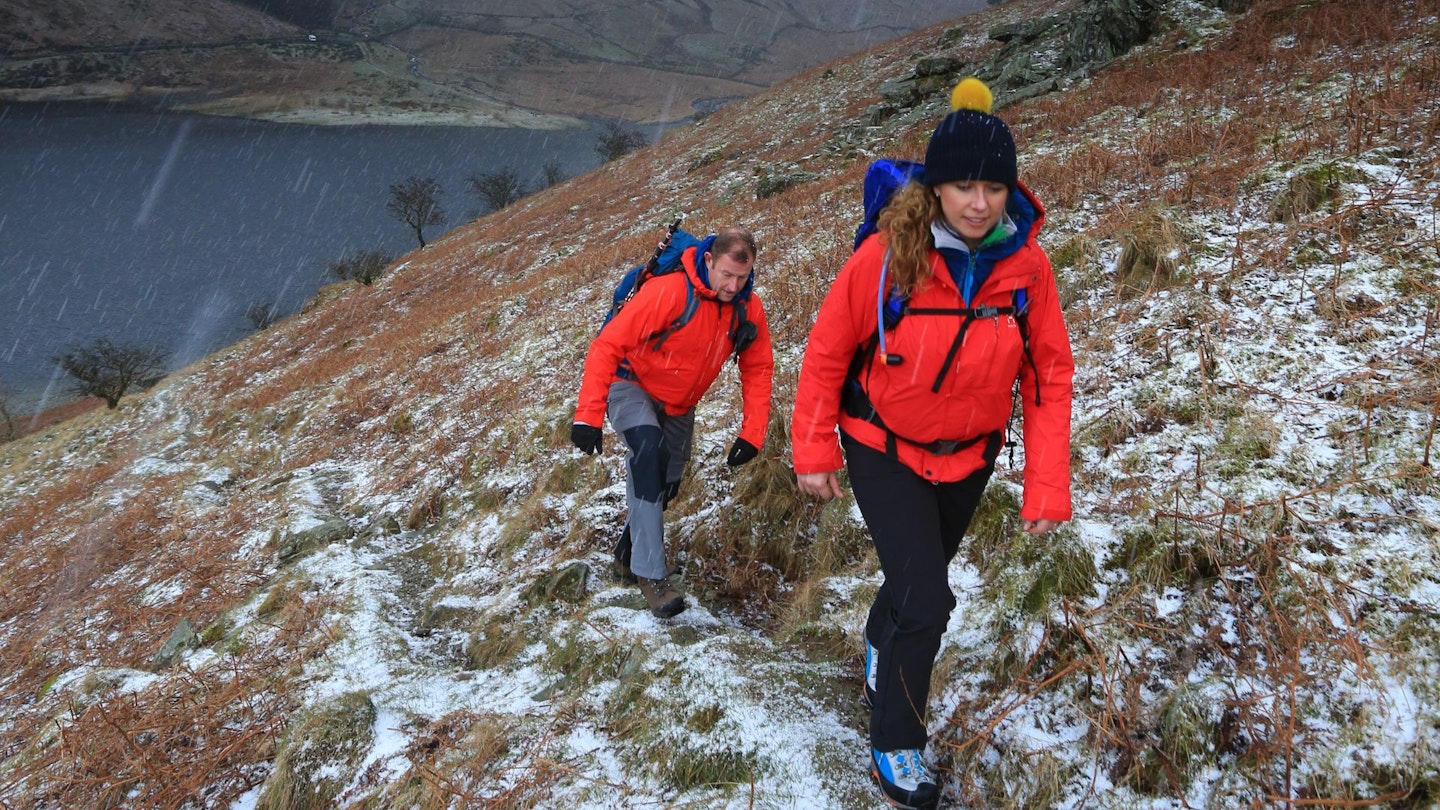
What level of waterproofing does a winter waterproof jacket need to have?
Not all waterproof hard shell jackets are created equal. Cheaper pairs can only cope with lighter showers; higher quality, winter-ready shells will keep you bone dry in the most torrential of downpours.
For an indication of how waterproof a jacket really is, check its hydrostatic head (HH) rating – the technical measurement of waterproofing.
Premium-end gear has a 20,000mm HH or higher, which means a 20m column of water can stand on the fabric before water penetrates it.
For premium waterproofing, all seams should be taped too. In terms of construction technique, waterproof jackets are generally categorised as 2, 2.5 or 3-layer, depending on how the waterproof layer is attached to other layers.
For poor weather 3-layer jackets are the most durable, with the waterproof layer sandwiched between a face fabric and inner scrim.
Gore-Tex tells us all of its fabrics have a minimum 28,000mm HH rating, but don’t state exact figures for the brand's different technologies, such as Gore-Tex Pro, Gore-Tex Performance and Gore-Tex Paclite.
Some brands use in-house proprietary membranes in their jackets, rather than using Gore-Tex, and consequently state their own HH ratings.
In this round-up, we’ve only selected jackets with a minimum HH of 20,000mm (except for the Páramo Alta III, which operates in a different way to traditional jackets)...
Does a winter waterproof jacket have to be Gore-Tex?
No. While Gore-Tex is a very reliable go-to technology for waterproof jackets (especially Gore-Tex Pro for winter waterproofs), there are many excellent alternatives. This is demonstrated by our shortlist of top winter waterproof jackets, where fewer than half use Gore-Tex.
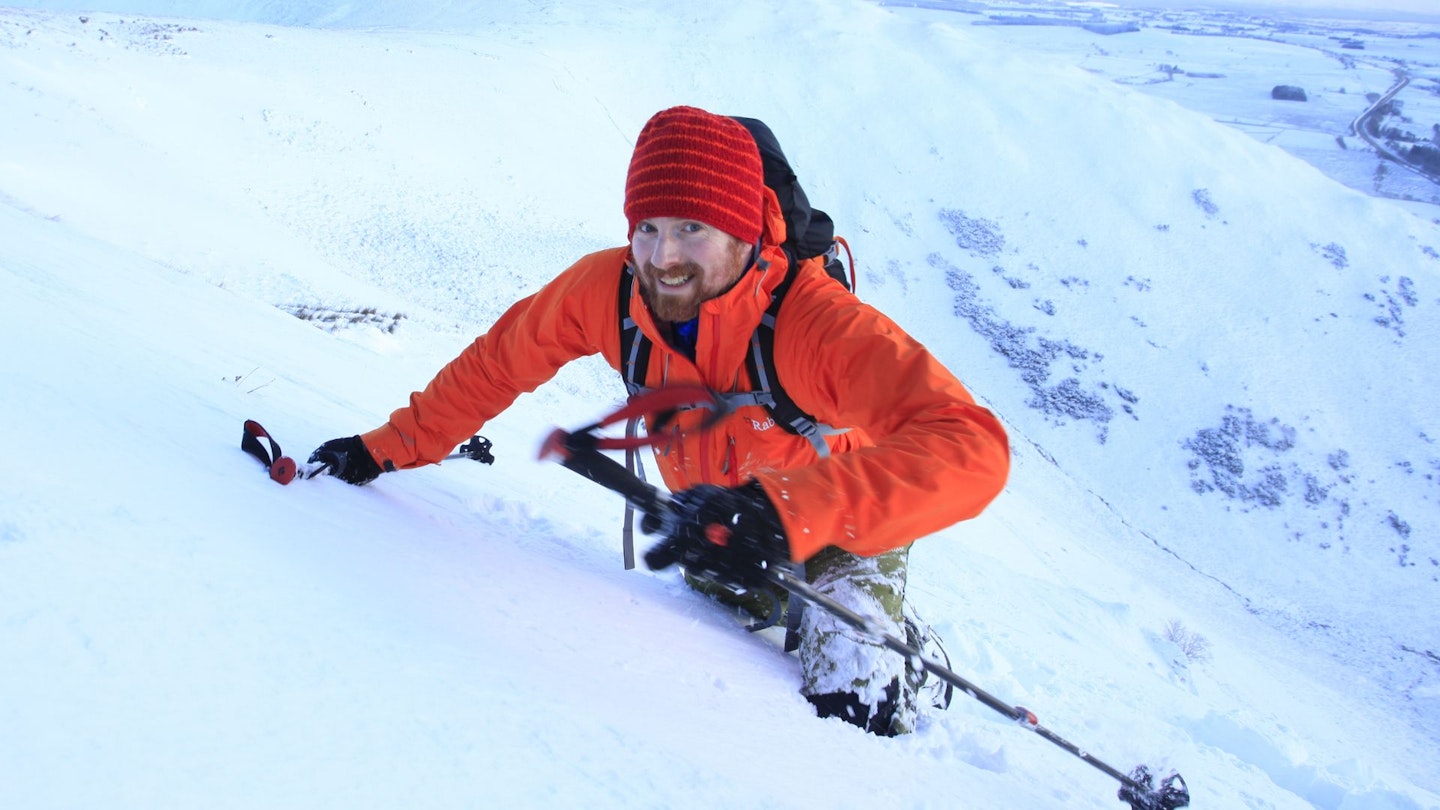
How breathable should a waterproof jacket be?
Waterproof jackets can feel clammy and sweat-inducing, so breathable fabrics are designed to keep rain out but simultaneously allow sweat to escape.
Does this work? Some argue yes, others believe when you’re exercising hard it’s virtually impossible to avoid sweaty condensation.
Breathability is commonly measured in two ways: an MVTR (moisture vapour transmission rate) in g/m²/24hr, with a higher figure indicating better breathability (20,000g/m²/24hr is considered a premium score); or a RET (resistance to evaporative heat transfer) score, with (confusingly) a lower figure indicating better breathability (a RET value of 0-6 is considered very good).
Ventilation options can also help improve all-round breathability. Commonly underarm zips (also known as pit zips) allow you to dump heat while on the move.
How should a winter waterproof jacket fit?
Hardy winter hardshells generally have a more relaxed fit than their summer counterparts to accommodate extra or thicker layers.
But this really is all about personal choice. Some will prefer a tighter, more athletic fit, while others will favour a baggier cut with more room for layering underneath.
Ideally, you want a jacket that moves and flexes with you, providing unhindered freedom of movement for dynamic mountain activities, even when wearing multiple layers underneath.
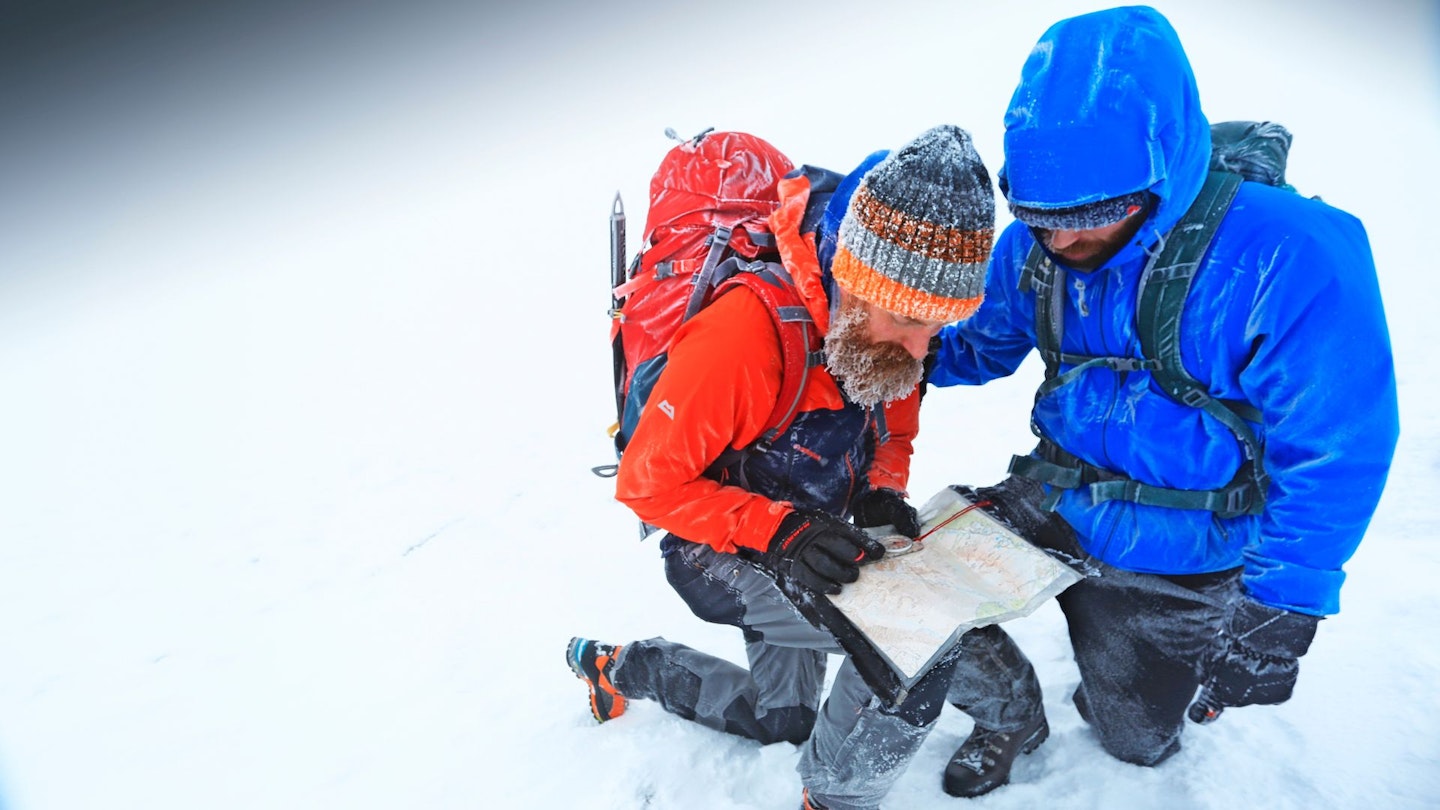
Are winter waterproof jackets heavy?
While ultralight waterproof jackets can weigh under 300g, those designed for harsh winter hikes are tougher, stronger and inevitably weigh more. The weight of a winter hardshell can range from about 400g up to a kilogram, with the majority clocking in between 500g and 600g.
Generally speaking, the higher weight indicates the use of more durable and protective materials designed for the worst of conditions.
What construction is best for winter waterproof jackets?
Jackets are generally categorised as 2, 2.5 or 3-layer, depending on how the waterproof layer is attached to other layers. For winter, 3-layer jackets are the most durable, with the waterproof layer sandwiched between a face fabric and inner scrim.
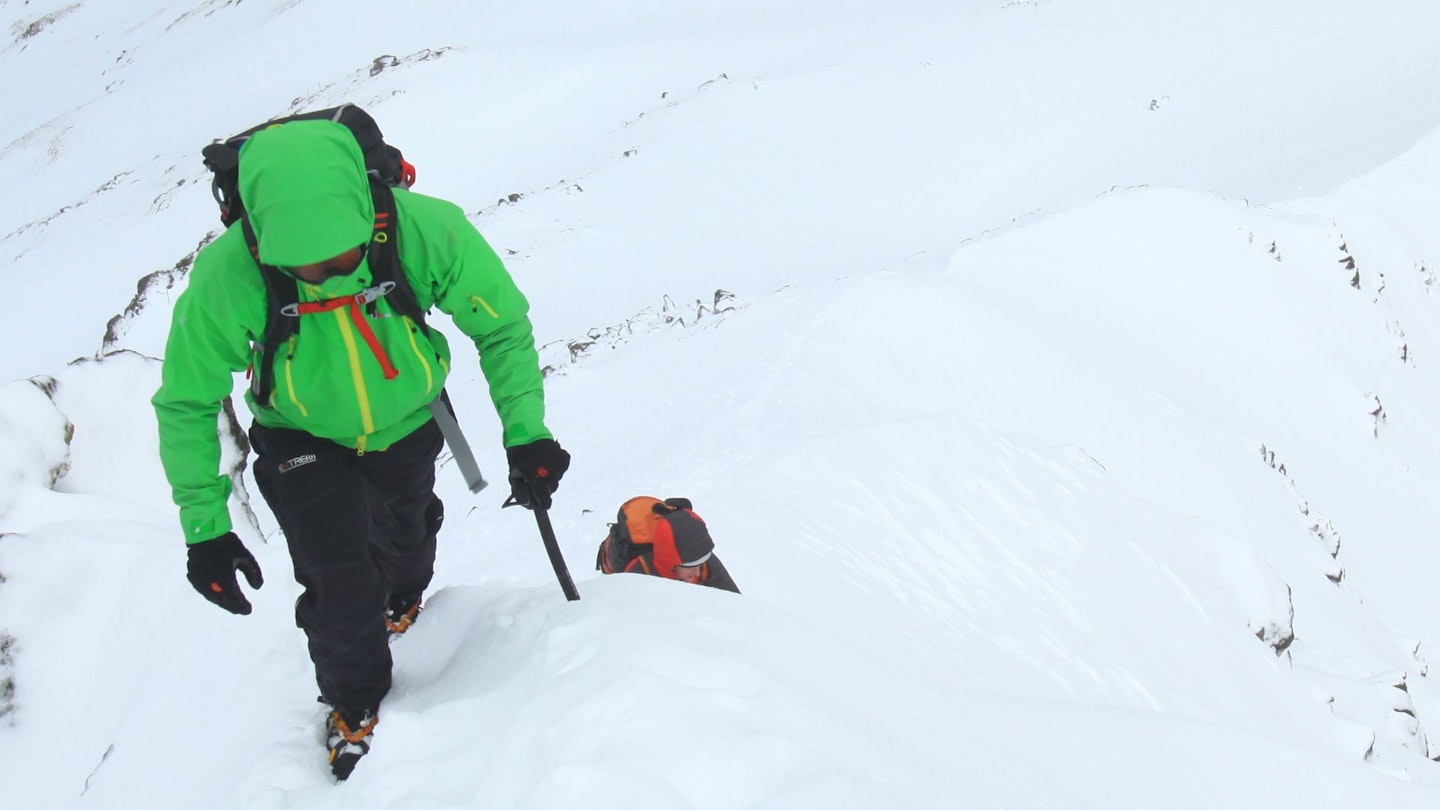
What other features are important?
A good hood should fit snugly and comfortably, but also move easily with the head so you can see where you’re going. Volume adjustment enables a fine-tuned fit, and ideally you want a stiffened brim and wired peak to keep rain off your face.
Adjustable cuffs – sealed with Velcro, or sometimes toggles or clips – are important because they enable a tight, fine-tuned fit around the wrist, preventing rain ingress.
Zips can be a point of weakness liable to water ingress. For maximum waterproofing, choose a jacket with a water-resistant zip protected by a sturdy stormflap.
Ideally you want a jacket that moves and flexes with you, providing unhindered freedom of movement for dynamic mountain activities.
Big pockets are great for storing OS maps, gloves, packs of Jelly Babies and whatever else you intend to put in them. Mesh-lined pockets aid overall ventilation but sealed pockets are more waterproof.
Waterproof jacket care and cleaning
Hiking jackets get a real workout and it doesn't take long for the fabric to get covered in muck and perspiration. A dirty jacket doesn't perform as well as a clean one, and its breathability and water repellency can suffer. Luckily cleaning and reproofing is easy.
Grangers and Nikwax both produce effective water-based, PFC-free gear cleaners and proofers. Used together, they clean waterproof fabrics, restore breathability, and revitalise water repellency.
Regarding waterproof jacket repairs, you’ll be pleased to know that most problems can be fixed. Even if it’s a tear in the waterproof fabric, a growing number of retailers and brands themselves are introducing or expanding their repair services. Make use of them – it's cost effective for you and a very important way to reduce the environmental impact of gear.
Best waterproof clothing cleaner

Bluesign approved and PFC-free, this water-based fabric cleaning is ideal for any technical or waterproof fabric, including Gore-Tex. It's highly concentrated too, so a little goes a long way.
Like Grangers, this is water-based and PFC-free. It too is a very effective cleaner of outdoor and technical garments. Really, there's nothing separating the effectiveness of Grangers and Nikwax.
This kit supplies a big one litre volume of Tech Wash and the 300ml bottle of reproofing TX.Direct. With TX.Direct, add it to the washing machine and run a second cycle after cleaning with Tech Wash.
This combo is perfect for cleaning outdoor garments and then adding durable water repellency to waterproof fabrics. The Performance Wash is used like a laundry detergent, while the Repel Plus is a simple spray.
Waterproof ratings explained
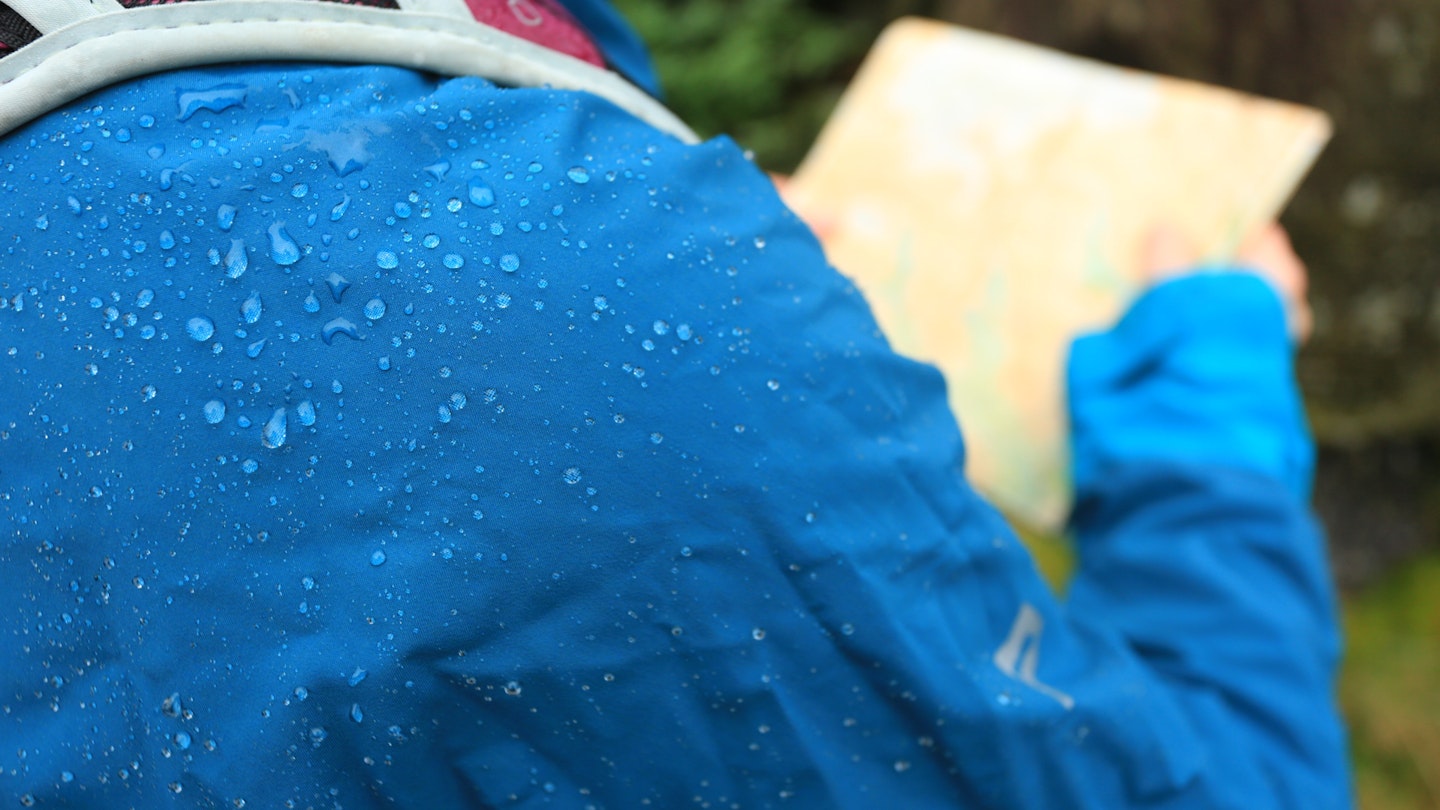
Like fill power with down insulation, waterproof ratings are very simple but widely misunderstood, or not known at all. Hydrostatic head is the industry standard for measuring waterproof fabrics; the waterproof fabrics used for waterproof jackets, tents, and so on.
The hydrostatic head figure given (for example, 10,000mm), indicates how high a column of water sitting on the fabric would need to be before water begins seeping through. It’s perhaps a slightly odd thing, but it’s an effective means of measurement.
It’s all to do with pressure. Obviously, testing labs don’t actually use such volumes of water, they use machines that apply equivalent downward pressure. Thus, a waterproof jacket with a hydrostatic head rating of 15,000mm for example, can withstand a 15-metre column of water before it leaks through.
Winter waterproof jackets should have a hydrostatic head of at least 20,000mm. It's not only more intense wet conditions they have to deal with, but the pressure from bigger, heavier winter packs.
Zips and seams are usual weak points in a jackets waterproofing. To combat this, some waterproof jackets have waterproof zips (or fabric cover flaps) and taped seams. Keep an eye out for these features when shopping around.
About the authors

As the former editor of Walk magazine and Scouting magazine, Matt is one of the most respected names in the UK outdoor industry.
Now a freelance journalist based in the heart of Snowdonia National Park, he’s a vastly experienced gear tester and self-confessed outdoor kit geek. Matt’s been one of our main gear testers for the last couple of years and is the first person we call with any complicated kit queries that need in-depth and forensic analysis.

Having climbed all of the UK and Ireland's 1,001 mountains in three years, it's fair to say James knows a thing or two about what works in terms of outdoor kit.
He's been reviewing gear and contributing to Trail magazine for a number of years and is a real authority on wild camping and multi-day walking.





